Corporate Philanthropy and Community Development
VerifiedAdded on 2021/04/19
|26
|7073
|21
AI Summary
The provided document is a compilation of various research papers and studies related to corporate philanthropy and community development. It includes articles from reputable sources such as Harvard Business Review, Journal of Business Ethics, and more. The document covers topics like the competitive advantage of corporate philanthropy, corporate philanthropy's impact on financial transparency, and how mega-events and natural disasters affect corporate philanthropy in US communities. It also discusses the effects of construal level priming and donation proximity on consumer response to donation framing. Overall, this document provides a comprehensive understanding of corporate philanthropy and its role in community development.
Contribute Materials
Your contribution can guide someone’s learning journey. Share your
documents today.

Running head: LITERATURE REVIEW
Literature review
Name of the Student
Name of the University
Author note
Literature review
Name of the Student
Name of the University
Author note
Secure Best Marks with AI Grader
Need help grading? Try our AI Grader for instant feedback on your assignments.
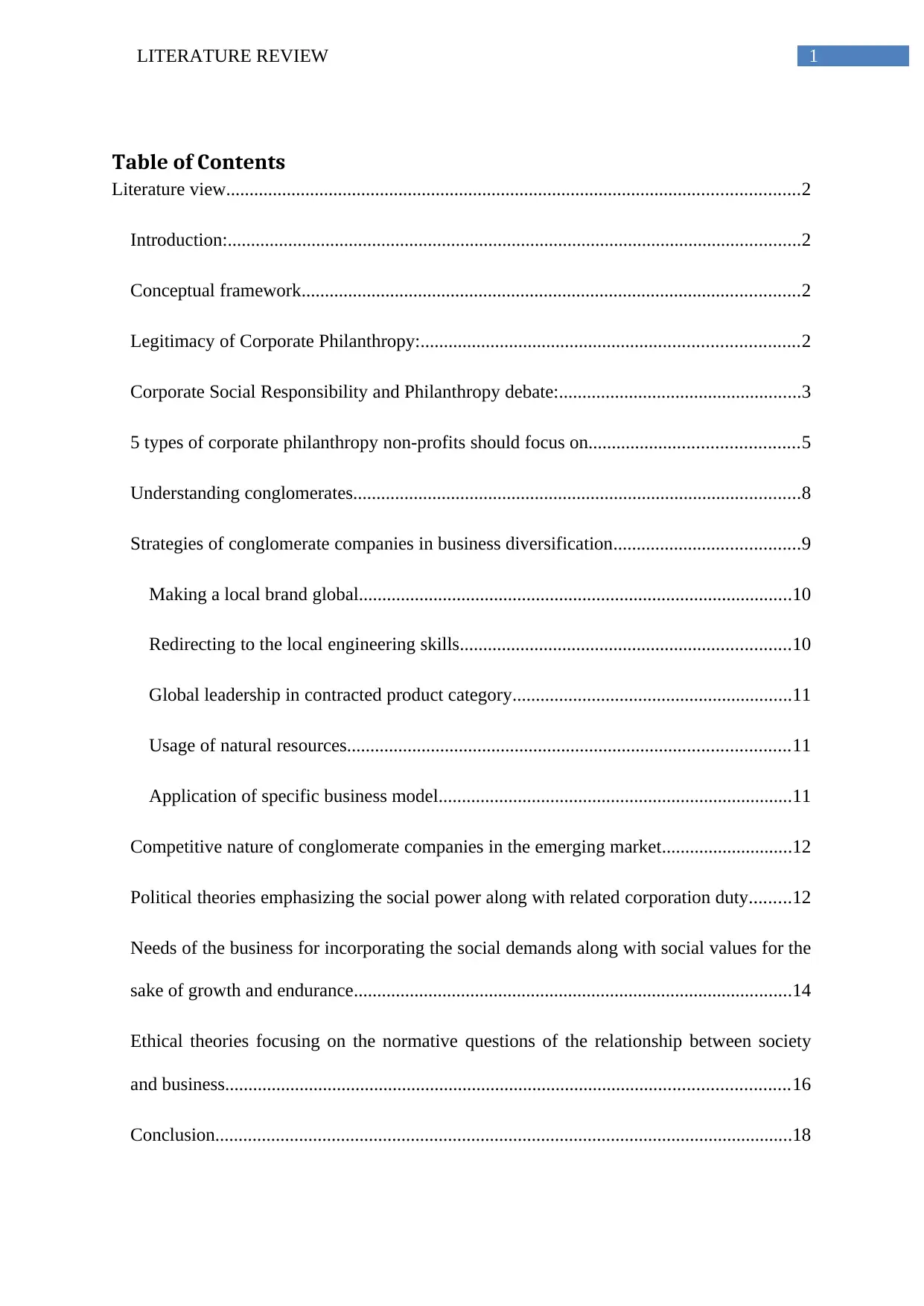
1LITERATURE REVIEW
Table of Contents
Literature view...........................................................................................................................2
Introduction:...........................................................................................................................2
Conceptual framework...........................................................................................................2
Legitimacy of Corporate Philanthropy:.................................................................................2
Corporate Social Responsibility and Philanthropy debate:....................................................3
5 types of corporate philanthropy non-profits should focus on.............................................5
Understanding conglomerates................................................................................................8
Strategies of conglomerate companies in business diversification........................................9
Making a local brand global.............................................................................................10
Redirecting to the local engineering skills.......................................................................10
Global leadership in contracted product category............................................................11
Usage of natural resources...............................................................................................11
Application of specific business model............................................................................11
Competitive nature of conglomerate companies in the emerging market............................12
Political theories emphasizing the social power along with related corporation duty.........12
Needs of the business for incorporating the social demands along with social values for the
sake of growth and endurance..............................................................................................14
Ethical theories focusing on the normative questions of the relationship between society
and business.........................................................................................................................16
Conclusion............................................................................................................................18
Table of Contents
Literature view...........................................................................................................................2
Introduction:...........................................................................................................................2
Conceptual framework...........................................................................................................2
Legitimacy of Corporate Philanthropy:.................................................................................2
Corporate Social Responsibility and Philanthropy debate:....................................................3
5 types of corporate philanthropy non-profits should focus on.............................................5
Understanding conglomerates................................................................................................8
Strategies of conglomerate companies in business diversification........................................9
Making a local brand global.............................................................................................10
Redirecting to the local engineering skills.......................................................................10
Global leadership in contracted product category............................................................11
Usage of natural resources...............................................................................................11
Application of specific business model............................................................................11
Competitive nature of conglomerate companies in the emerging market............................12
Political theories emphasizing the social power along with related corporation duty.........12
Needs of the business for incorporating the social demands along with social values for the
sake of growth and endurance..............................................................................................14
Ethical theories focusing on the normative questions of the relationship between society
and business.........................................................................................................................16
Conclusion............................................................................................................................18

2LITERATURE REVIEW
References................................................................................................................................19
References................................................................................................................................19
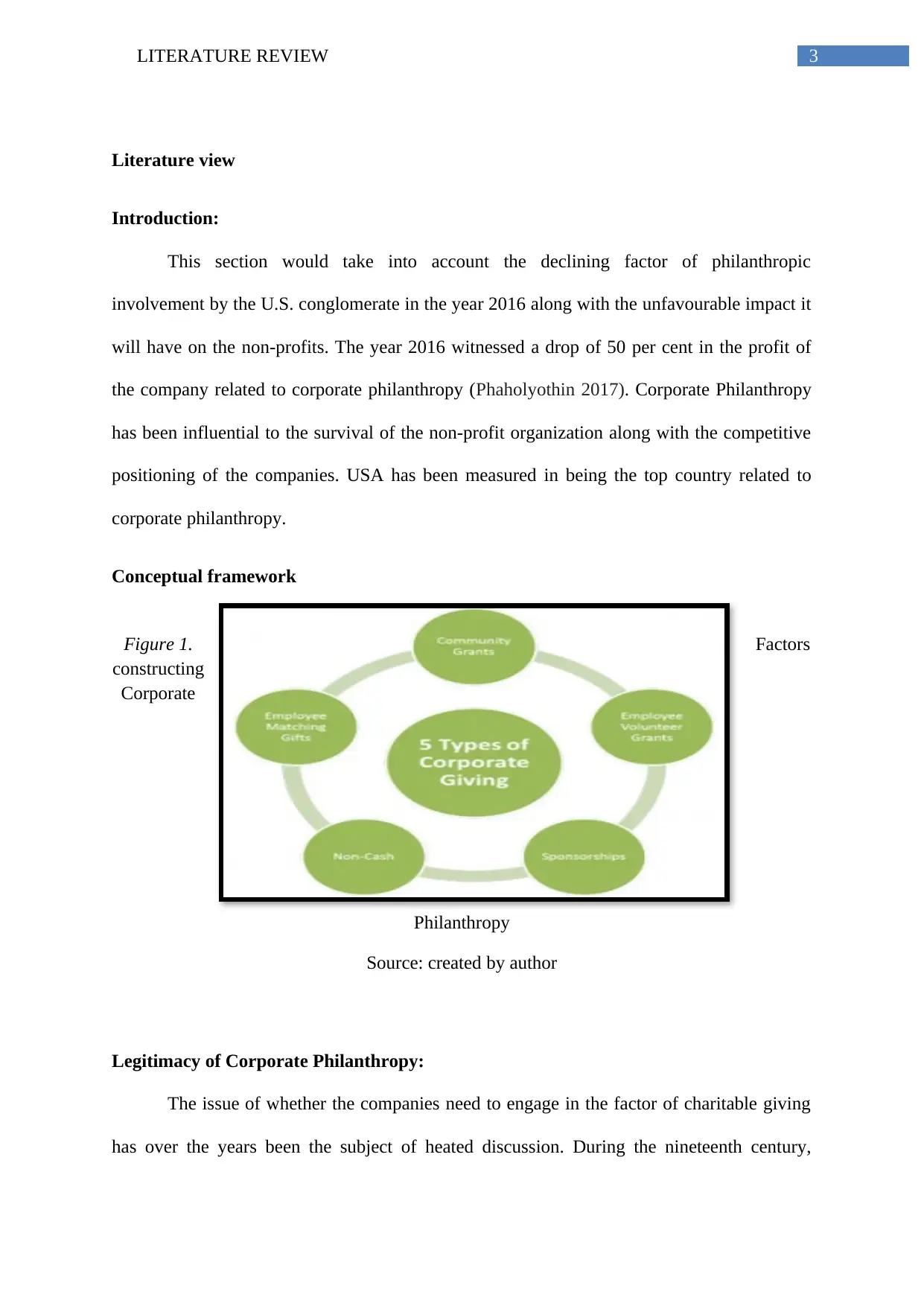
3LITERATURE REVIEW
Literature view
Introduction:
This section would take into account the declining factor of philanthropic
involvement by the U.S. conglomerate in the year 2016 along with the unfavourable impact it
will have on the non-profits. The year 2016 witnessed a drop of 50 per cent in the profit of
the company related to corporate philanthropy (Phaholyothin 2017). Corporate Philanthropy
has been influential to the survival of the non-profit organization along with the competitive
positioning of the companies. USA has been measured in being the top country related to
corporate philanthropy.
Conceptual framework
Figure 1. Factors
constructing
Corporate
Philanthropy
Source: created by author
Legitimacy of Corporate Philanthropy:
The issue of whether the companies need to engage in the factor of charitable giving
has over the years been the subject of heated discussion. During the nineteenth century,
Literature view
Introduction:
This section would take into account the declining factor of philanthropic
involvement by the U.S. conglomerate in the year 2016 along with the unfavourable impact it
will have on the non-profits. The year 2016 witnessed a drop of 50 per cent in the profit of
the company related to corporate philanthropy (Phaholyothin 2017). Corporate Philanthropy
has been influential to the survival of the non-profit organization along with the competitive
positioning of the companies. USA has been measured in being the top country related to
corporate philanthropy.
Conceptual framework
Figure 1. Factors
constructing
Corporate
Philanthropy
Source: created by author
Legitimacy of Corporate Philanthropy:
The issue of whether the companies need to engage in the factor of charitable giving
has over the years been the subject of heated discussion. During the nineteenth century,
Secure Best Marks with AI Grader
Need help grading? Try our AI Grader for instant feedback on your assignments.
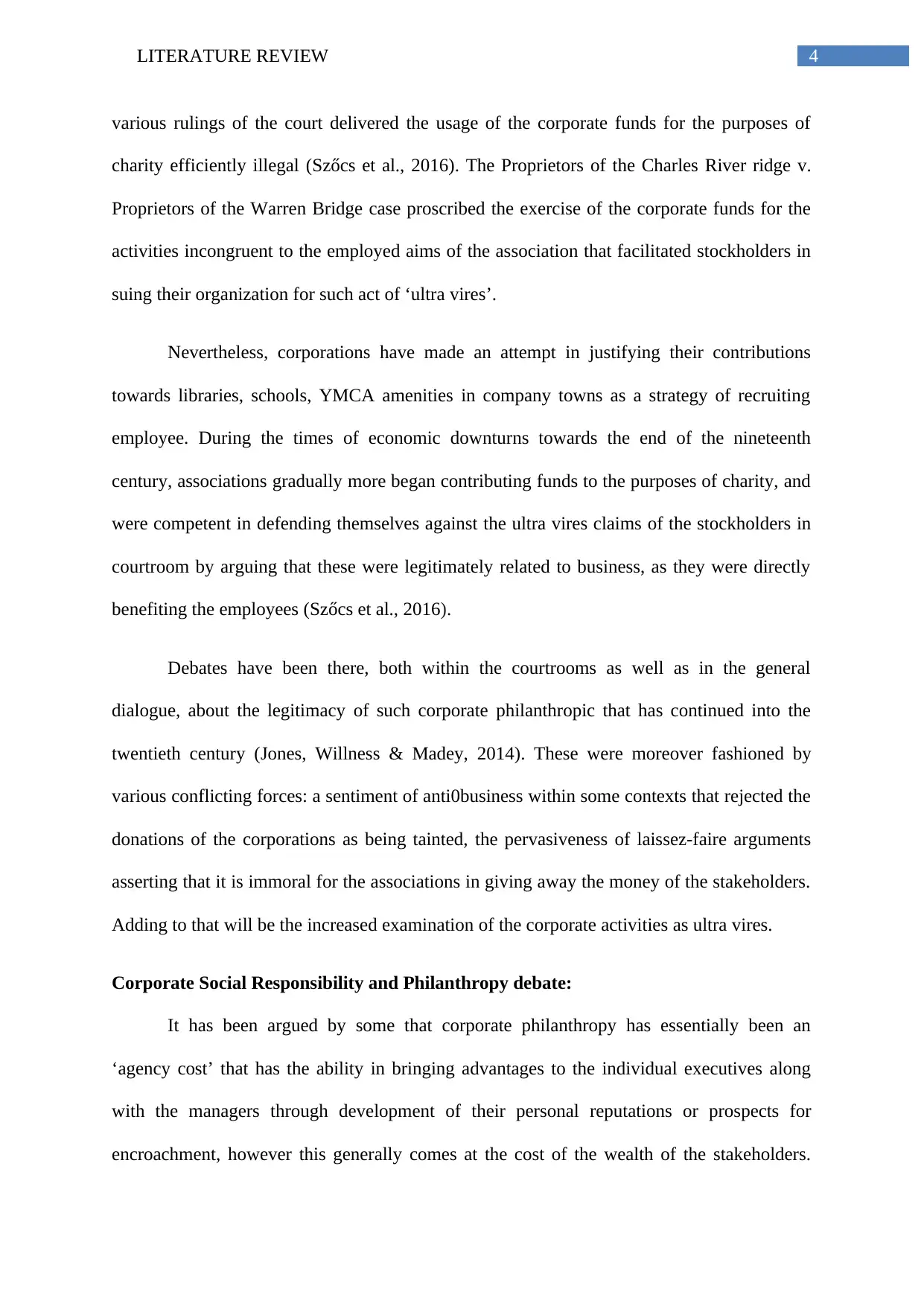
4LITERATURE REVIEW
various rulings of the court delivered the usage of the corporate funds for the purposes of
charity efficiently illegal (Szőcs et al., 2016). The Proprietors of the Charles River ridge v.
Proprietors of the Warren Bridge case proscribed the exercise of the corporate funds for the
activities incongruent to the employed aims of the association that facilitated stockholders in
suing their organization for such act of ‘ultra vires’.
Nevertheless, corporations have made an attempt in justifying their contributions
towards libraries, schools, YMCA amenities in company towns as a strategy of recruiting
employee. During the times of economic downturns towards the end of the nineteenth
century, associations gradually more began contributing funds to the purposes of charity, and
were competent in defending themselves against the ultra vires claims of the stockholders in
courtroom by arguing that these were legitimately related to business, as they were directly
benefiting the employees (Szőcs et al., 2016).
Debates have been there, both within the courtrooms as well as in the general
dialogue, about the legitimacy of such corporate philanthropic that has continued into the
twentieth century (Jones, Willness & Madey, 2014). These were moreover fashioned by
various conflicting forces: a sentiment of anti0business within some contexts that rejected the
donations of the corporations as being tainted, the pervasiveness of laissez-faire arguments
asserting that it is immoral for the associations in giving away the money of the stakeholders.
Adding to that will be the increased examination of the corporate activities as ultra vires.
Corporate Social Responsibility and Philanthropy debate:
It has been argued by some that corporate philanthropy has essentially been an
‘agency cost’ that has the ability in bringing advantages to the individual executives along
with the managers through development of their personal reputations or prospects for
encroachment, however this generally comes at the cost of the wealth of the stakeholders.
various rulings of the court delivered the usage of the corporate funds for the purposes of
charity efficiently illegal (Szőcs et al., 2016). The Proprietors of the Charles River ridge v.
Proprietors of the Warren Bridge case proscribed the exercise of the corporate funds for the
activities incongruent to the employed aims of the association that facilitated stockholders in
suing their organization for such act of ‘ultra vires’.
Nevertheless, corporations have made an attempt in justifying their contributions
towards libraries, schools, YMCA amenities in company towns as a strategy of recruiting
employee. During the times of economic downturns towards the end of the nineteenth
century, associations gradually more began contributing funds to the purposes of charity, and
were competent in defending themselves against the ultra vires claims of the stockholders in
courtroom by arguing that these were legitimately related to business, as they were directly
benefiting the employees (Szőcs et al., 2016).
Debates have been there, both within the courtrooms as well as in the general
dialogue, about the legitimacy of such corporate philanthropic that has continued into the
twentieth century (Jones, Willness & Madey, 2014). These were moreover fashioned by
various conflicting forces: a sentiment of anti0business within some contexts that rejected the
donations of the corporations as being tainted, the pervasiveness of laissez-faire arguments
asserting that it is immoral for the associations in giving away the money of the stakeholders.
Adding to that will be the increased examination of the corporate activities as ultra vires.
Corporate Social Responsibility and Philanthropy debate:
It has been argued by some that corporate philanthropy has essentially been an
‘agency cost’ that has the ability in bringing advantages to the individual executives along
with the managers through development of their personal reputations or prospects for
encroachment, however this generally comes at the cost of the wealth of the stakeholders.
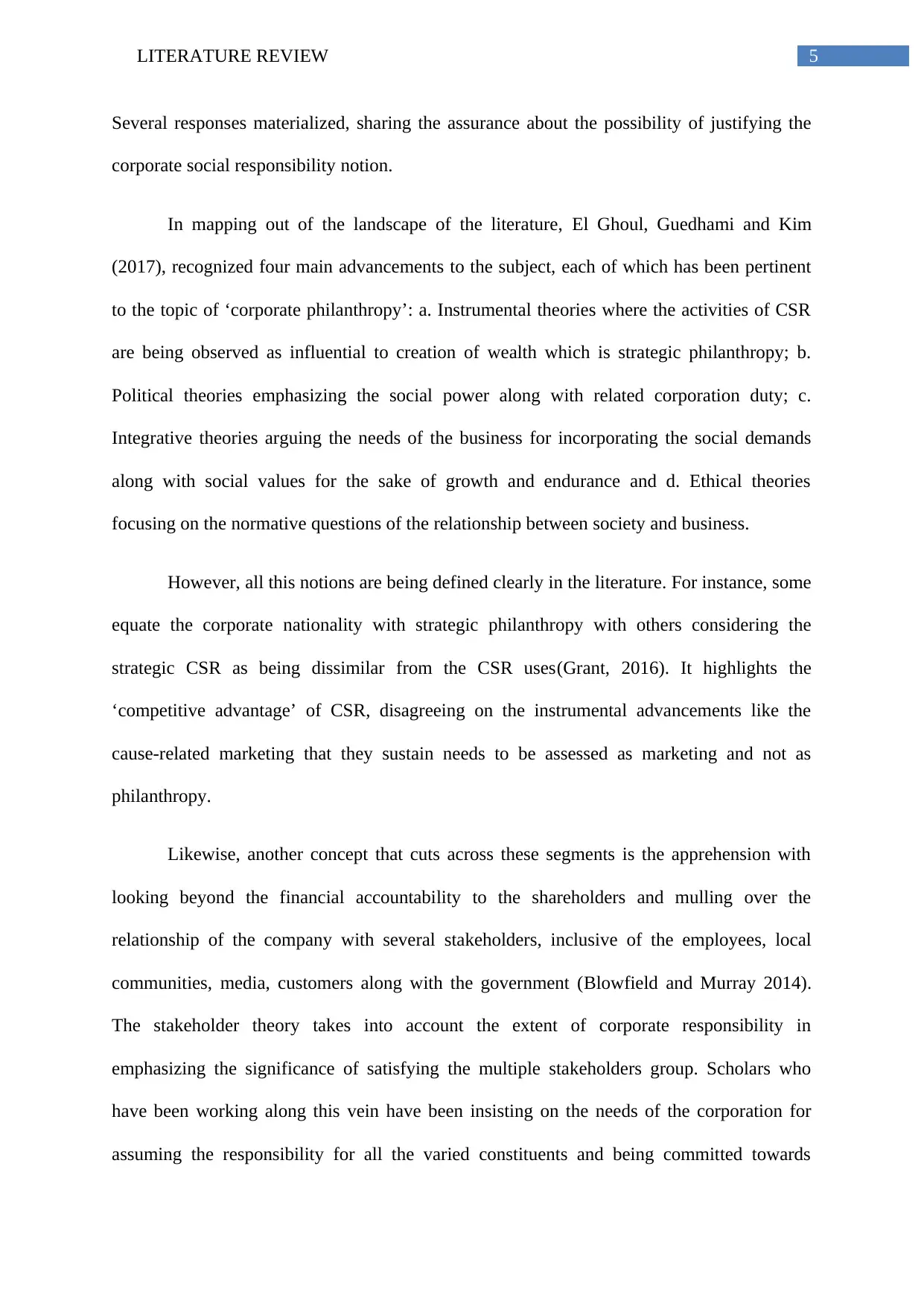
5LITERATURE REVIEW
Several responses materialized, sharing the assurance about the possibility of justifying the
corporate social responsibility notion.
In mapping out of the landscape of the literature, El Ghoul, Guedhami and Kim
(2017), recognized four main advancements to the subject, each of which has been pertinent
to the topic of ‘corporate philanthropy’: a. Instrumental theories where the activities of CSR
are being observed as influential to creation of wealth which is strategic philanthropy; b.
Political theories emphasizing the social power along with related corporation duty; c.
Integrative theories arguing the needs of the business for incorporating the social demands
along with social values for the sake of growth and endurance and d. Ethical theories
focusing on the normative questions of the relationship between society and business.
However, all this notions are being defined clearly in the literature. For instance, some
equate the corporate nationality with strategic philanthropy with others considering the
strategic CSR as being dissimilar from the CSR uses(Grant, 2016). It highlights the
‘competitive advantage’ of CSR, disagreeing on the instrumental advancements like the
cause-related marketing that they sustain needs to be assessed as marketing and not as
philanthropy.
Likewise, another concept that cuts across these segments is the apprehension with
looking beyond the financial accountability to the shareholders and mulling over the
relationship of the company with several stakeholders, inclusive of the employees, local
communities, media, customers along with the government (Blowfield and Murray 2014).
The stakeholder theory takes into account the extent of corporate responsibility in
emphasizing the significance of satisfying the multiple stakeholders group. Scholars who
have been working along this vein have been insisting on the needs of the corporation for
assuming the responsibility for all the varied constituents and being committed towards
Several responses materialized, sharing the assurance about the possibility of justifying the
corporate social responsibility notion.
In mapping out of the landscape of the literature, El Ghoul, Guedhami and Kim
(2017), recognized four main advancements to the subject, each of which has been pertinent
to the topic of ‘corporate philanthropy’: a. Instrumental theories where the activities of CSR
are being observed as influential to creation of wealth which is strategic philanthropy; b.
Political theories emphasizing the social power along with related corporation duty; c.
Integrative theories arguing the needs of the business for incorporating the social demands
along with social values for the sake of growth and endurance and d. Ethical theories
focusing on the normative questions of the relationship between society and business.
However, all this notions are being defined clearly in the literature. For instance, some
equate the corporate nationality with strategic philanthropy with others considering the
strategic CSR as being dissimilar from the CSR uses(Grant, 2016). It highlights the
‘competitive advantage’ of CSR, disagreeing on the instrumental advancements like the
cause-related marketing that they sustain needs to be assessed as marketing and not as
philanthropy.
Likewise, another concept that cuts across these segments is the apprehension with
looking beyond the financial accountability to the shareholders and mulling over the
relationship of the company with several stakeholders, inclusive of the employees, local
communities, media, customers along with the government (Blowfield and Murray 2014).
The stakeholder theory takes into account the extent of corporate responsibility in
emphasizing the significance of satisfying the multiple stakeholders group. Scholars who
have been working along this vein have been insisting on the needs of the corporation for
assuming the responsibility for all the varied constituents and being committed towards
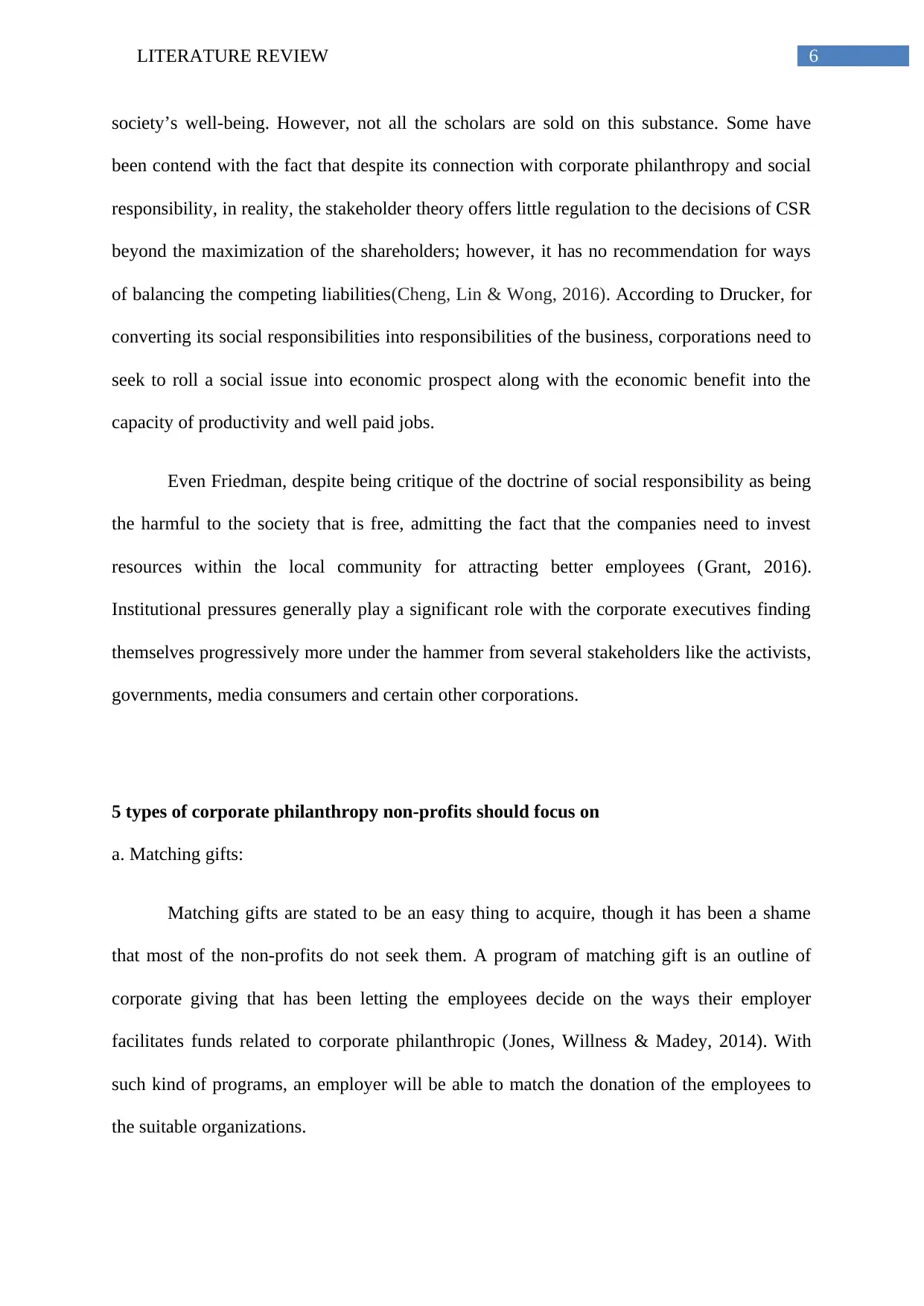
6LITERATURE REVIEW
society’s well-being. However, not all the scholars are sold on this substance. Some have
been contend with the fact that despite its connection with corporate philanthropy and social
responsibility, in reality, the stakeholder theory offers little regulation to the decisions of CSR
beyond the maximization of the shareholders; however, it has no recommendation for ways
of balancing the competing liabilities(Cheng, Lin & Wong, 2016). According to Drucker, for
converting its social responsibilities into responsibilities of the business, corporations need to
seek to roll a social issue into economic prospect along with the economic benefit into the
capacity of productivity and well paid jobs.
Even Friedman, despite being critique of the doctrine of social responsibility as being
the harmful to the society that is free, admitting the fact that the companies need to invest
resources within the local community for attracting better employees (Grant, 2016).
Institutional pressures generally play a significant role with the corporate executives finding
themselves progressively more under the hammer from several stakeholders like the activists,
governments, media consumers and certain other corporations.
5 types of corporate philanthropy non-profits should focus on
a. Matching gifts:
Matching gifts are stated to be an easy thing to acquire, though it has been a shame
that most of the non-profits do not seek them. A program of matching gift is an outline of
corporate giving that has been letting the employees decide on the ways their employer
facilitates funds related to corporate philanthropic (Jones, Willness & Madey, 2014). With
such kind of programs, an employer will be able to match the donation of the employees to
the suitable organizations.
society’s well-being. However, not all the scholars are sold on this substance. Some have
been contend with the fact that despite its connection with corporate philanthropy and social
responsibility, in reality, the stakeholder theory offers little regulation to the decisions of CSR
beyond the maximization of the shareholders; however, it has no recommendation for ways
of balancing the competing liabilities(Cheng, Lin & Wong, 2016). According to Drucker, for
converting its social responsibilities into responsibilities of the business, corporations need to
seek to roll a social issue into economic prospect along with the economic benefit into the
capacity of productivity and well paid jobs.
Even Friedman, despite being critique of the doctrine of social responsibility as being
the harmful to the society that is free, admitting the fact that the companies need to invest
resources within the local community for attracting better employees (Grant, 2016).
Institutional pressures generally play a significant role with the corporate executives finding
themselves progressively more under the hammer from several stakeholders like the activists,
governments, media consumers and certain other corporations.
5 types of corporate philanthropy non-profits should focus on
a. Matching gifts:
Matching gifts are stated to be an easy thing to acquire, though it has been a shame
that most of the non-profits do not seek them. A program of matching gift is an outline of
corporate giving that has been letting the employees decide on the ways their employer
facilitates funds related to corporate philanthropic (Jones, Willness & Madey, 2014). With
such kind of programs, an employer will be able to match the donation of the employees to
the suitable organizations.
Paraphrase This Document
Need a fresh take? Get an instant paraphrase of this document with our AI Paraphraser
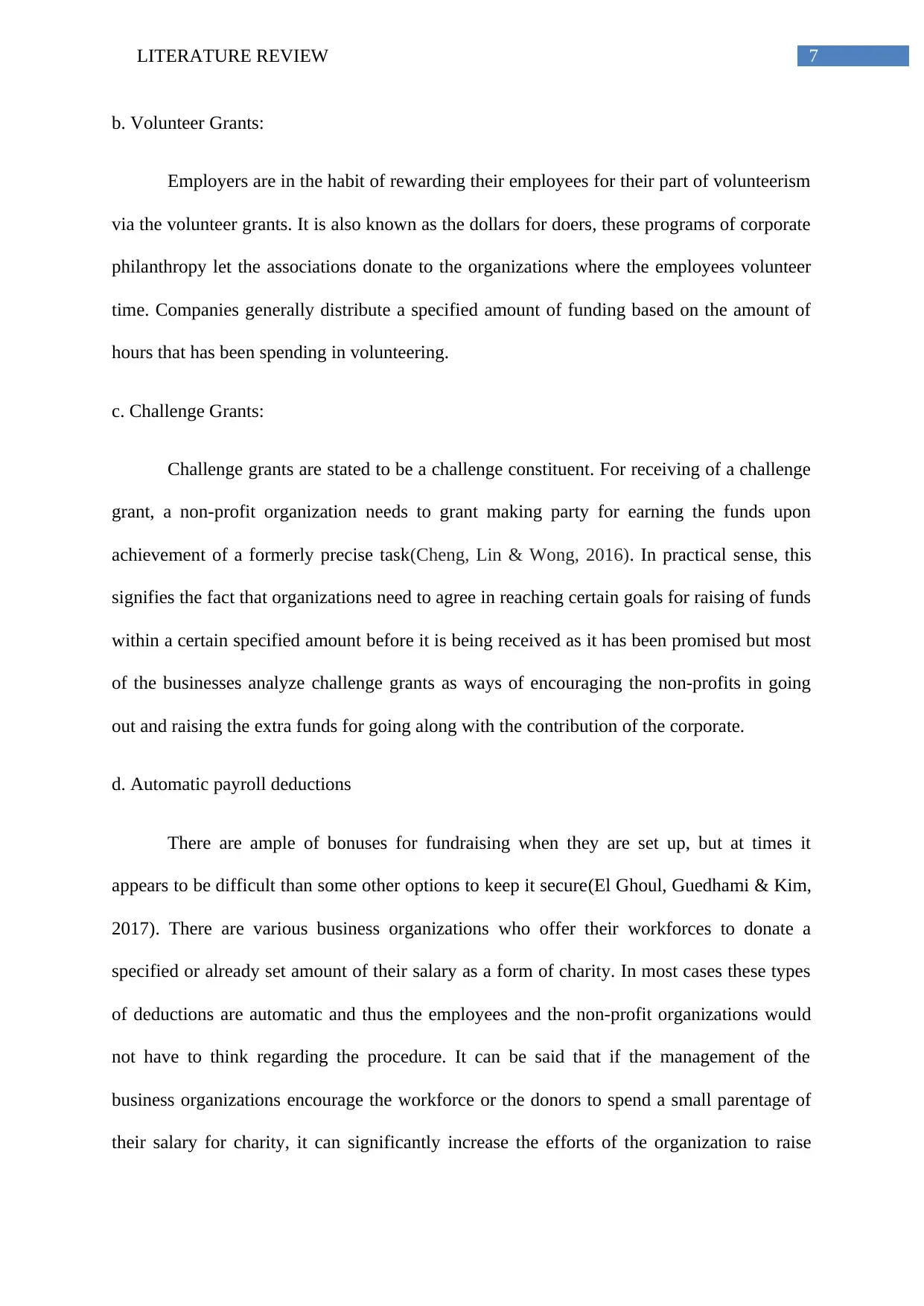
7LITERATURE REVIEW
b. Volunteer Grants:
Employers are in the habit of rewarding their employees for their part of volunteerism
via the volunteer grants. It is also known as the dollars for doers, these programs of corporate
philanthropy let the associations donate to the organizations where the employees volunteer
time. Companies generally distribute a specified amount of funding based on the amount of
hours that has been spending in volunteering.
c. Challenge Grants:
Challenge grants are stated to be a challenge constituent. For receiving of a challenge
grant, a non-profit organization needs to grant making party for earning the funds upon
achievement of a formerly precise task(Cheng, Lin & Wong, 2016). In practical sense, this
signifies the fact that organizations need to agree in reaching certain goals for raising of funds
within a certain specified amount before it is being received as it has been promised but most
of the businesses analyze challenge grants as ways of encouraging the non-profits in going
out and raising the extra funds for going along with the contribution of the corporate.
d. Automatic payroll deductions
There are ample of bonuses for fundraising when they are set up, but at times it
appears to be difficult than some other options to keep it secure(El Ghoul, Guedhami & Kim,
2017). There are various business organizations who offer their workforces to donate a
specified or already set amount of their salary as a form of charity. In most cases these types
of deductions are automatic and thus the employees and the non-profit organizations would
not have to think regarding the procedure. It can be said that if the management of the
business organizations encourage the workforce or the donors to spend a small parentage of
their salary for charity, it can significantly increase the efforts of the organization to raise
b. Volunteer Grants:
Employers are in the habit of rewarding their employees for their part of volunteerism
via the volunteer grants. It is also known as the dollars for doers, these programs of corporate
philanthropy let the associations donate to the organizations where the employees volunteer
time. Companies generally distribute a specified amount of funding based on the amount of
hours that has been spending in volunteering.
c. Challenge Grants:
Challenge grants are stated to be a challenge constituent. For receiving of a challenge
grant, a non-profit organization needs to grant making party for earning the funds upon
achievement of a formerly precise task(Cheng, Lin & Wong, 2016). In practical sense, this
signifies the fact that organizations need to agree in reaching certain goals for raising of funds
within a certain specified amount before it is being received as it has been promised but most
of the businesses analyze challenge grants as ways of encouraging the non-profits in going
out and raising the extra funds for going along with the contribution of the corporate.
d. Automatic payroll deductions
There are ample of bonuses for fundraising when they are set up, but at times it
appears to be difficult than some other options to keep it secure(El Ghoul, Guedhami & Kim,
2017). There are various business organizations who offer their workforces to donate a
specified or already set amount of their salary as a form of charity. In most cases these types
of deductions are automatic and thus the employees and the non-profit organizations would
not have to think regarding the procedure. It can be said that if the management of the
business organizations encourage the workforce or the donors to spend a small parentage of
their salary for charity, it can significantly increase the efforts of the organization to raise
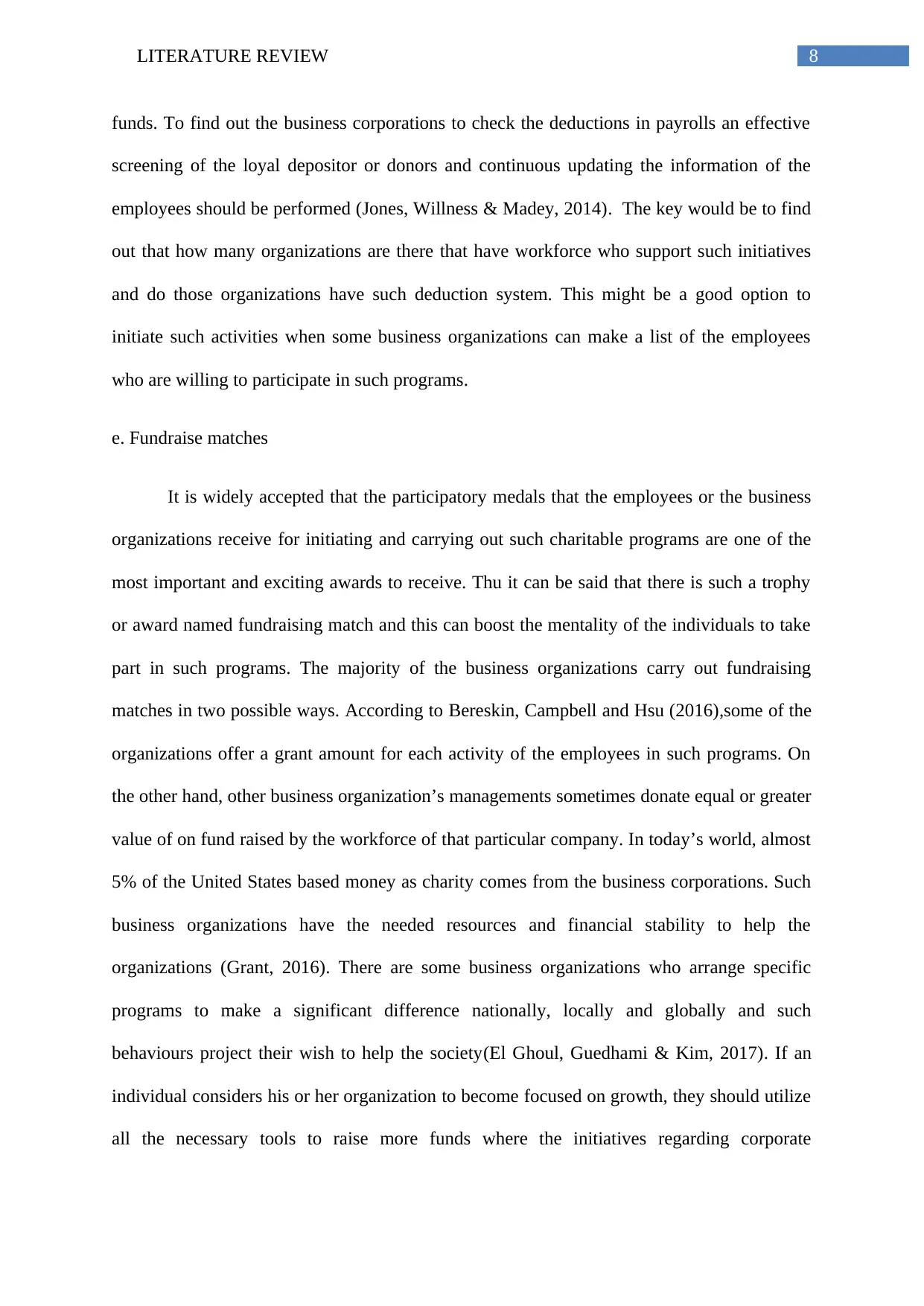
8LITERATURE REVIEW
funds. To find out the business corporations to check the deductions in payrolls an effective
screening of the loyal depositor or donors and continuous updating the information of the
employees should be performed (Jones, Willness & Madey, 2014). The key would be to find
out that how many organizations are there that have workforce who support such initiatives
and do those organizations have such deduction system. This might be a good option to
initiate such activities when some business organizations can make a list of the employees
who are willing to participate in such programs.
e. Fundraise matches
It is widely accepted that the participatory medals that the employees or the business
organizations receive for initiating and carrying out such charitable programs are one of the
most important and exciting awards to receive. Thu it can be said that there is such a trophy
or award named fundraising match and this can boost the mentality of the individuals to take
part in such programs. The majority of the business organizations carry out fundraising
matches in two possible ways. According to Bereskin, Campbell and Hsu (2016),some of the
organizations offer a grant amount for each activity of the employees in such programs. On
the other hand, other business organization’s managements sometimes donate equal or greater
value of on fund raised by the workforce of that particular company. In today’s world, almost
5% of the United States based money as charity comes from the business corporations. Such
business organizations have the needed resources and financial stability to help the
organizations (Grant, 2016). There are some business organizations who arrange specific
programs to make a significant difference nationally, locally and globally and such
behaviours project their wish to help the society(El Ghoul, Guedhami & Kim, 2017). If an
individual considers his or her organization to become focused on growth, they should utilize
all the necessary tools to raise more funds where the initiatives regarding corporate
funds. To find out the business corporations to check the deductions in payrolls an effective
screening of the loyal depositor or donors and continuous updating the information of the
employees should be performed (Jones, Willness & Madey, 2014). The key would be to find
out that how many organizations are there that have workforce who support such initiatives
and do those organizations have such deduction system. This might be a good option to
initiate such activities when some business organizations can make a list of the employees
who are willing to participate in such programs.
e. Fundraise matches
It is widely accepted that the participatory medals that the employees or the business
organizations receive for initiating and carrying out such charitable programs are one of the
most important and exciting awards to receive. Thu it can be said that there is such a trophy
or award named fundraising match and this can boost the mentality of the individuals to take
part in such programs. The majority of the business organizations carry out fundraising
matches in two possible ways. According to Bereskin, Campbell and Hsu (2016),some of the
organizations offer a grant amount for each activity of the employees in such programs. On
the other hand, other business organization’s managements sometimes donate equal or greater
value of on fund raised by the workforce of that particular company. In today’s world, almost
5% of the United States based money as charity comes from the business corporations. Such
business organizations have the needed resources and financial stability to help the
organizations (Grant, 2016). There are some business organizations who arrange specific
programs to make a significant difference nationally, locally and globally and such
behaviours project their wish to help the society(El Ghoul, Guedhami & Kim, 2017). If an
individual considers his or her organization to become focused on growth, they should utilize
all the necessary tools to raise more funds where the initiatives regarding corporate
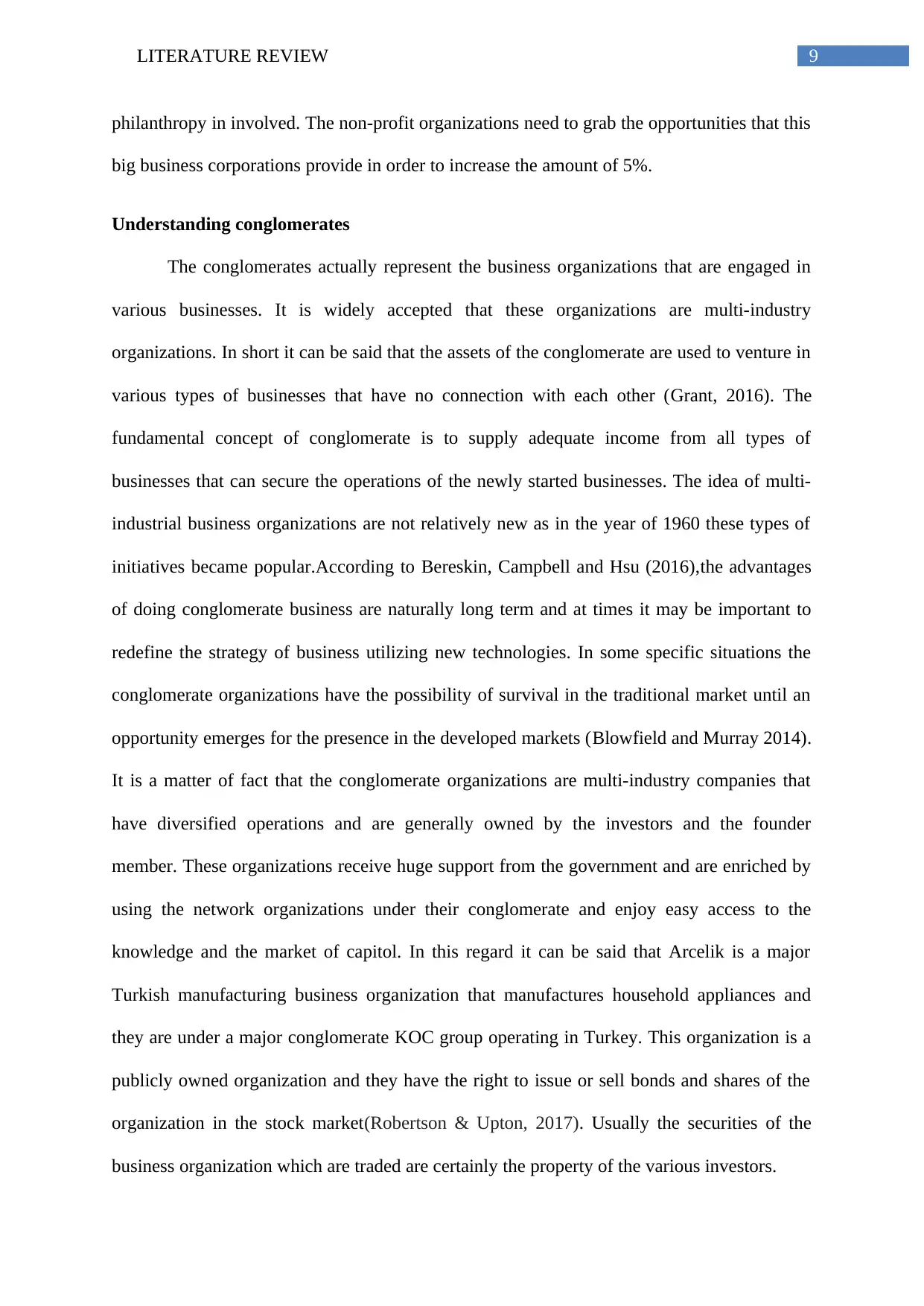
9LITERATURE REVIEW
philanthropy in involved. The non-profit organizations need to grab the opportunities that this
big business corporations provide in order to increase the amount of 5%.
Understanding conglomerates
The conglomerates actually represent the business organizations that are engaged in
various businesses. It is widely accepted that these organizations are multi-industry
organizations. In short it can be said that the assets of the conglomerate are used to venture in
various types of businesses that have no connection with each other (Grant, 2016). The
fundamental concept of conglomerate is to supply adequate income from all types of
businesses that can secure the operations of the newly started businesses. The idea of multi-
industrial business organizations are not relatively new as in the year of 1960 these types of
initiatives became popular.According to Bereskin, Campbell and Hsu (2016),the advantages
of doing conglomerate business are naturally long term and at times it may be important to
redefine the strategy of business utilizing new technologies. In some specific situations the
conglomerate organizations have the possibility of survival in the traditional market until an
opportunity emerges for the presence in the developed markets (Blowfield and Murray 2014).
It is a matter of fact that the conglomerate organizations are multi-industry companies that
have diversified operations and are generally owned by the investors and the founder
member. These organizations receive huge support from the government and are enriched by
using the network organizations under their conglomerate and enjoy easy access to the
knowledge and the market of capitol. In this regard it can be said that Arcelik is a major
Turkish manufacturing business organization that manufactures household appliances and
they are under a major conglomerate KOC group operating in Turkey. This organization is a
publicly owned organization and they have the right to issue or sell bonds and shares of the
organization in the stock market(Robertson & Upton, 2017). Usually the securities of the
business organization which are traded are certainly the property of the various investors.
philanthropy in involved. The non-profit organizations need to grab the opportunities that this
big business corporations provide in order to increase the amount of 5%.
Understanding conglomerates
The conglomerates actually represent the business organizations that are engaged in
various businesses. It is widely accepted that these organizations are multi-industry
organizations. In short it can be said that the assets of the conglomerate are used to venture in
various types of businesses that have no connection with each other (Grant, 2016). The
fundamental concept of conglomerate is to supply adequate income from all types of
businesses that can secure the operations of the newly started businesses. The idea of multi-
industrial business organizations are not relatively new as in the year of 1960 these types of
initiatives became popular.According to Bereskin, Campbell and Hsu (2016),the advantages
of doing conglomerate business are naturally long term and at times it may be important to
redefine the strategy of business utilizing new technologies. In some specific situations the
conglomerate organizations have the possibility of survival in the traditional market until an
opportunity emerges for the presence in the developed markets (Blowfield and Murray 2014).
It is a matter of fact that the conglomerate organizations are multi-industry companies that
have diversified operations and are generally owned by the investors and the founder
member. These organizations receive huge support from the government and are enriched by
using the network organizations under their conglomerate and enjoy easy access to the
knowledge and the market of capitol. In this regard it can be said that Arcelik is a major
Turkish manufacturing business organization that manufactures household appliances and
they are under a major conglomerate KOC group operating in Turkey. This organization is a
publicly owned organization and they have the right to issue or sell bonds and shares of the
organization in the stock market(Robertson & Upton, 2017). Usually the securities of the
business organization which are traded are certainly the property of the various investors.
Secure Best Marks with AI Grader
Need help grading? Try our AI Grader for instant feedback on your assignments.
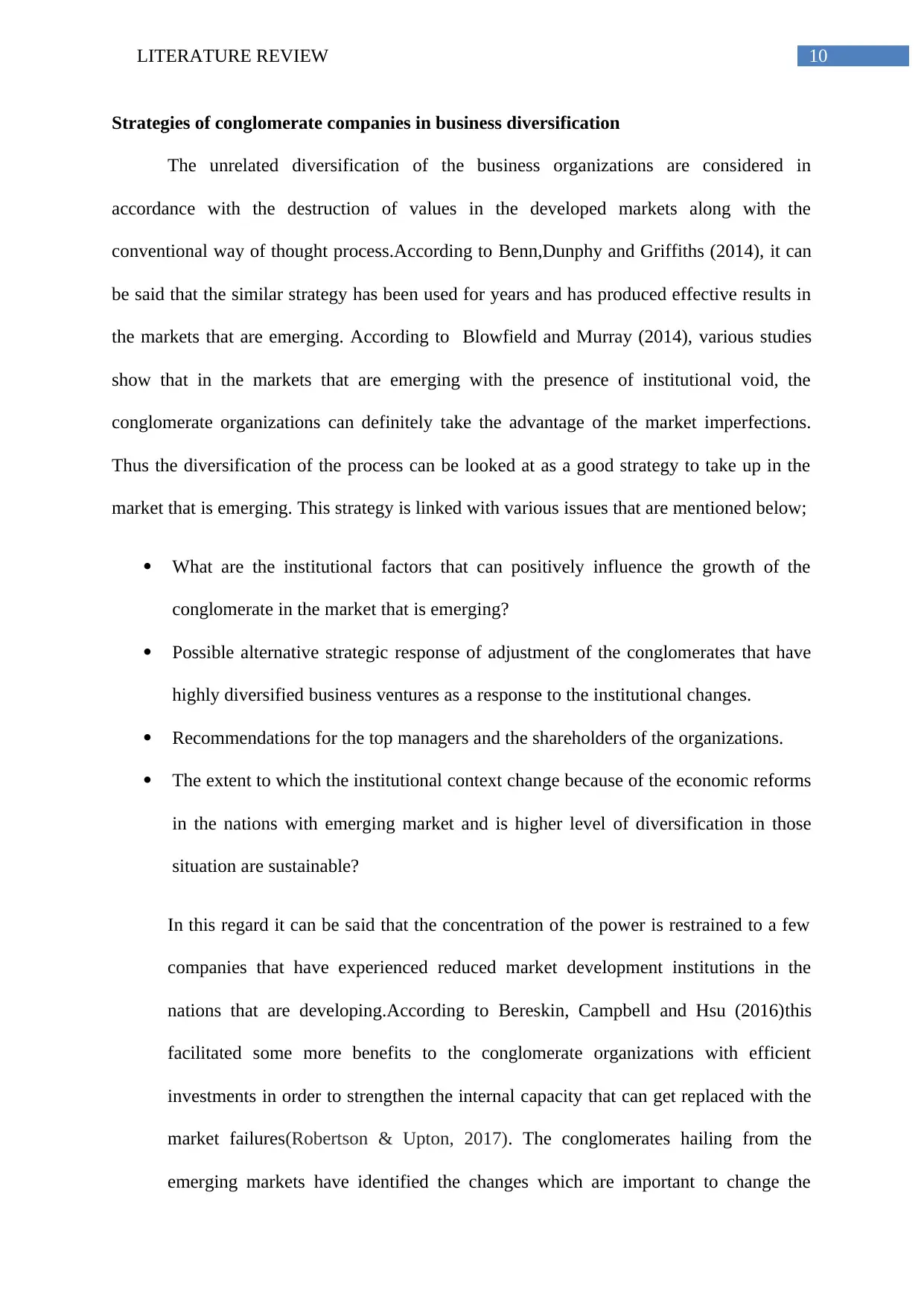
10LITERATURE REVIEW
Strategies of conglomerate companies in business diversification
The unrelated diversification of the business organizations are considered in
accordance with the destruction of values in the developed markets along with the
conventional way of thought process.According to Benn,Dunphy and Griffiths (2014), it can
be said that the similar strategy has been used for years and has produced effective results in
the markets that are emerging. According to Blowfield and Murray (2014), various studies
show that in the markets that are emerging with the presence of institutional void, the
conglomerate organizations can definitely take the advantage of the market imperfections.
Thus the diversification of the process can be looked at as a good strategy to take up in the
market that is emerging. This strategy is linked with various issues that are mentioned below;
What are the institutional factors that can positively influence the growth of the
conglomerate in the market that is emerging?
Possible alternative strategic response of adjustment of the conglomerates that have
highly diversified business ventures as a response to the institutional changes.
Recommendations for the top managers and the shareholders of the organizations.
The extent to which the institutional context change because of the economic reforms
in the nations with emerging market and is higher level of diversification in those
situation are sustainable?
In this regard it can be said that the concentration of the power is restrained to a few
companies that have experienced reduced market development institutions in the
nations that are developing.According to Bereskin, Campbell and Hsu (2016)this
facilitated some more benefits to the conglomerate organizations with efficient
investments in order to strengthen the internal capacity that can get replaced with the
market failures(Robertson & Upton, 2017). The conglomerates hailing from the
emerging markets have identified the changes which are important to change the
Strategies of conglomerate companies in business diversification
The unrelated diversification of the business organizations are considered in
accordance with the destruction of values in the developed markets along with the
conventional way of thought process.According to Benn,Dunphy and Griffiths (2014), it can
be said that the similar strategy has been used for years and has produced effective results in
the markets that are emerging. According to Blowfield and Murray (2014), various studies
show that in the markets that are emerging with the presence of institutional void, the
conglomerate organizations can definitely take the advantage of the market imperfections.
Thus the diversification of the process can be looked at as a good strategy to take up in the
market that is emerging. This strategy is linked with various issues that are mentioned below;
What are the institutional factors that can positively influence the growth of the
conglomerate in the market that is emerging?
Possible alternative strategic response of adjustment of the conglomerates that have
highly diversified business ventures as a response to the institutional changes.
Recommendations for the top managers and the shareholders of the organizations.
The extent to which the institutional context change because of the economic reforms
in the nations with emerging market and is higher level of diversification in those
situation are sustainable?
In this regard it can be said that the concentration of the power is restrained to a few
companies that have experienced reduced market development institutions in the
nations that are developing.According to Bereskin, Campbell and Hsu (2016)this
facilitated some more benefits to the conglomerate organizations with efficient
investments in order to strengthen the internal capacity that can get replaced with the
market failures(Robertson & Upton, 2017). The conglomerates hailing from the
emerging markets have identified the changes which are important to change the
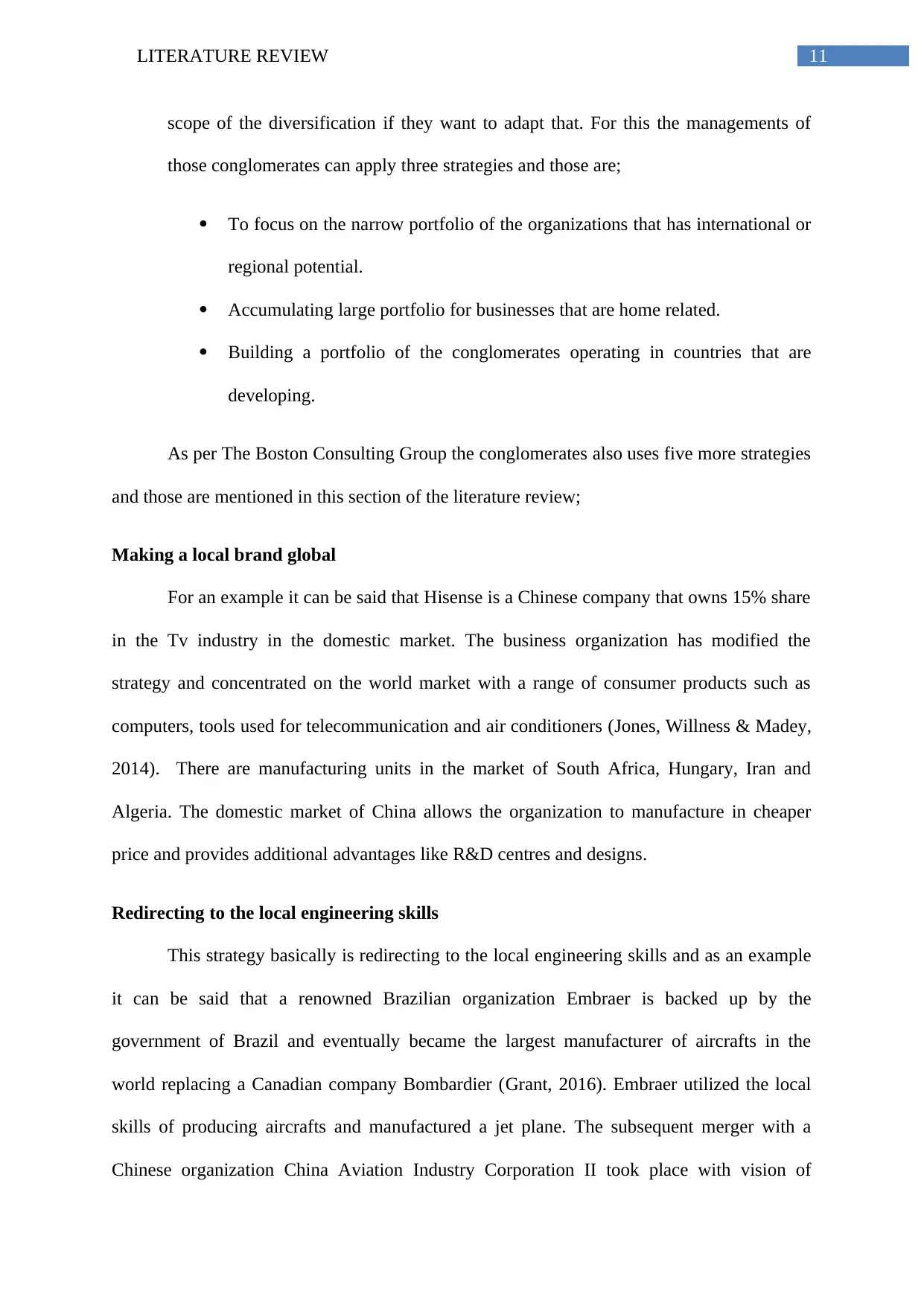
11LITERATURE REVIEW
scope of the diversification if they want to adapt that. For this the managements of
those conglomerates can apply three strategies and those are;
To focus on the narrow portfolio of the organizations that has international or
regional potential.
Accumulating large portfolio for businesses that are home related.
Building a portfolio of the conglomerates operating in countries that are
developing.
As per The Boston Consulting Group the conglomerates also uses five more strategies
and those are mentioned in this section of the literature review;
Making a local brand global
For an example it can be said that Hisense is a Chinese company that owns 15% share
in the Tv industry in the domestic market. The business organization has modified the
strategy and concentrated on the world market with a range of consumer products such as
computers, tools used for telecommunication and air conditioners (Jones, Willness & Madey,
2014). There are manufacturing units in the market of South Africa, Hungary, Iran and
Algeria. The domestic market of China allows the organization to manufacture in cheaper
price and provides additional advantages like R&D centres and designs.
Redirecting to the local engineering skills
This strategy basically is redirecting to the local engineering skills and as an example
it can be said that a renowned Brazilian organization Embraer is backed up by the
government of Brazil and eventually became the largest manufacturer of aircrafts in the
world replacing a Canadian company Bombardier (Grant, 2016). Embraer utilized the local
skills of producing aircrafts and manufactured a jet plane. The subsequent merger with a
Chinese organization China Aviation Industry Corporation II took place with vision of
scope of the diversification if they want to adapt that. For this the managements of
those conglomerates can apply three strategies and those are;
To focus on the narrow portfolio of the organizations that has international or
regional potential.
Accumulating large portfolio for businesses that are home related.
Building a portfolio of the conglomerates operating in countries that are
developing.
As per The Boston Consulting Group the conglomerates also uses five more strategies
and those are mentioned in this section of the literature review;
Making a local brand global
For an example it can be said that Hisense is a Chinese company that owns 15% share
in the Tv industry in the domestic market. The business organization has modified the
strategy and concentrated on the world market with a range of consumer products such as
computers, tools used for telecommunication and air conditioners (Jones, Willness & Madey,
2014). There are manufacturing units in the market of South Africa, Hungary, Iran and
Algeria. The domestic market of China allows the organization to manufacture in cheaper
price and provides additional advantages like R&D centres and designs.
Redirecting to the local engineering skills
This strategy basically is redirecting to the local engineering skills and as an example
it can be said that a renowned Brazilian organization Embraer is backed up by the
government of Brazil and eventually became the largest manufacturer of aircrafts in the
world replacing a Canadian company Bombardier (Grant, 2016). Embraer utilized the local
skills of producing aircrafts and manufactured a jet plane. The subsequent merger with a
Chinese organization China Aviation Industry Corporation II took place with vision of
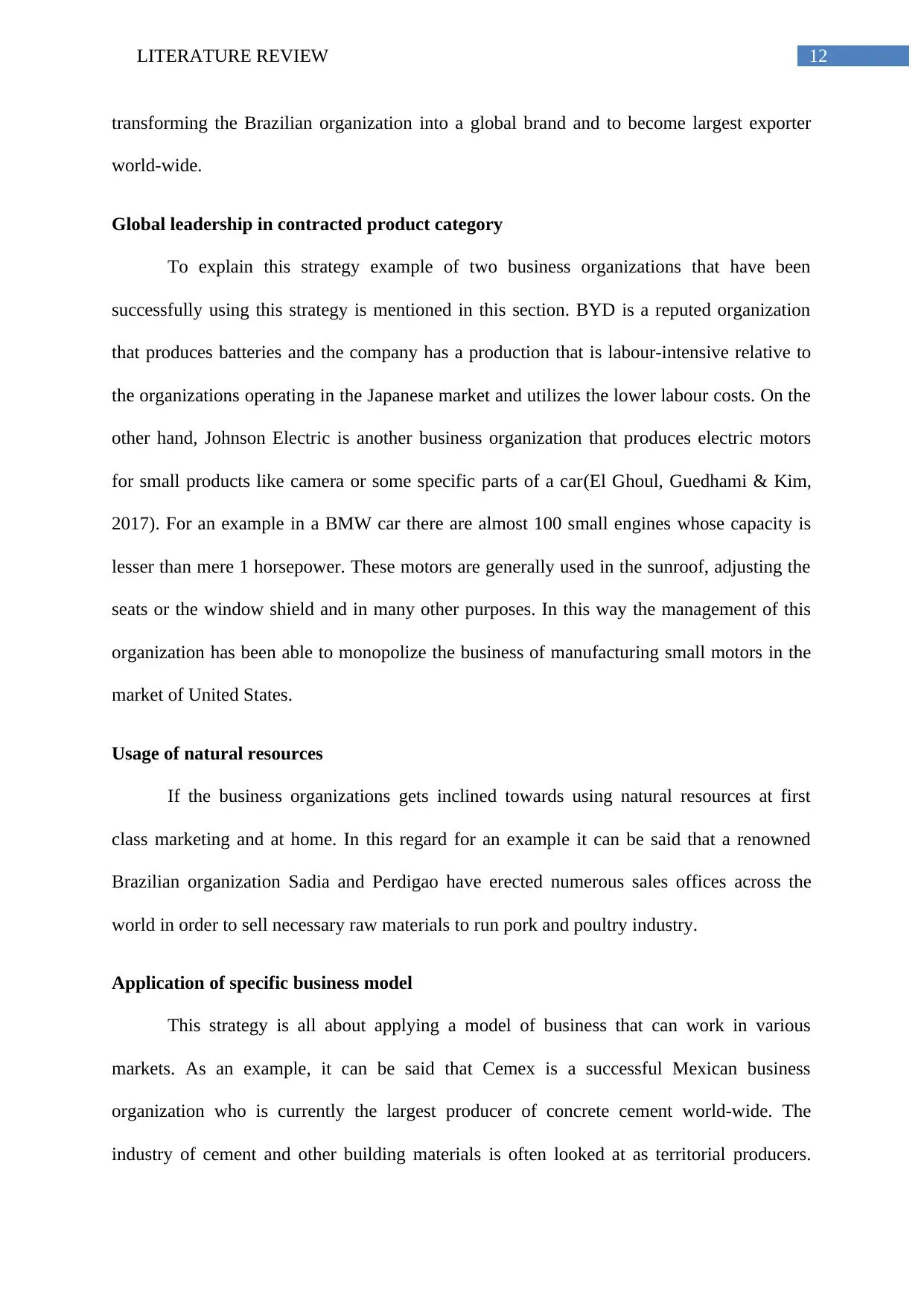
12LITERATURE REVIEW
transforming the Brazilian organization into a global brand and to become largest exporter
world-wide.
Global leadership in contracted product category
To explain this strategy example of two business organizations that have been
successfully using this strategy is mentioned in this section. BYD is a reputed organization
that produces batteries and the company has a production that is labour-intensive relative to
the organizations operating in the Japanese market and utilizes the lower labour costs. On the
other hand, Johnson Electric is another business organization that produces electric motors
for small products like camera or some specific parts of a car(El Ghoul, Guedhami & Kim,
2017). For an example in a BMW car there are almost 100 small engines whose capacity is
lesser than mere 1 horsepower. These motors are generally used in the sunroof, adjusting the
seats or the window shield and in many other purposes. In this way the management of this
organization has been able to monopolize the business of manufacturing small motors in the
market of United States.
Usage of natural resources
If the business organizations gets inclined towards using natural resources at first
class marketing and at home. In this regard for an example it can be said that a renowned
Brazilian organization Sadia and Perdigao have erected numerous sales offices across the
world in order to sell necessary raw materials to run pork and poultry industry.
Application of specific business model
This strategy is all about applying a model of business that can work in various
markets. As an example, it can be said that Cemex is a successful Mexican business
organization who is currently the largest producer of concrete cement world-wide. The
industry of cement and other building materials is often looked at as territorial producers.
transforming the Brazilian organization into a global brand and to become largest exporter
world-wide.
Global leadership in contracted product category
To explain this strategy example of two business organizations that have been
successfully using this strategy is mentioned in this section. BYD is a reputed organization
that produces batteries and the company has a production that is labour-intensive relative to
the organizations operating in the Japanese market and utilizes the lower labour costs. On the
other hand, Johnson Electric is another business organization that produces electric motors
for small products like camera or some specific parts of a car(El Ghoul, Guedhami & Kim,
2017). For an example in a BMW car there are almost 100 small engines whose capacity is
lesser than mere 1 horsepower. These motors are generally used in the sunroof, adjusting the
seats or the window shield and in many other purposes. In this way the management of this
organization has been able to monopolize the business of manufacturing small motors in the
market of United States.
Usage of natural resources
If the business organizations gets inclined towards using natural resources at first
class marketing and at home. In this regard for an example it can be said that a renowned
Brazilian organization Sadia and Perdigao have erected numerous sales offices across the
world in order to sell necessary raw materials to run pork and poultry industry.
Application of specific business model
This strategy is all about applying a model of business that can work in various
markets. As an example, it can be said that Cemex is a successful Mexican business
organization who is currently the largest producer of concrete cement world-wide. The
industry of cement and other building materials is often looked at as territorial producers.
Paraphrase This Document
Need a fresh take? Get an instant paraphrase of this document with our AI Paraphraser
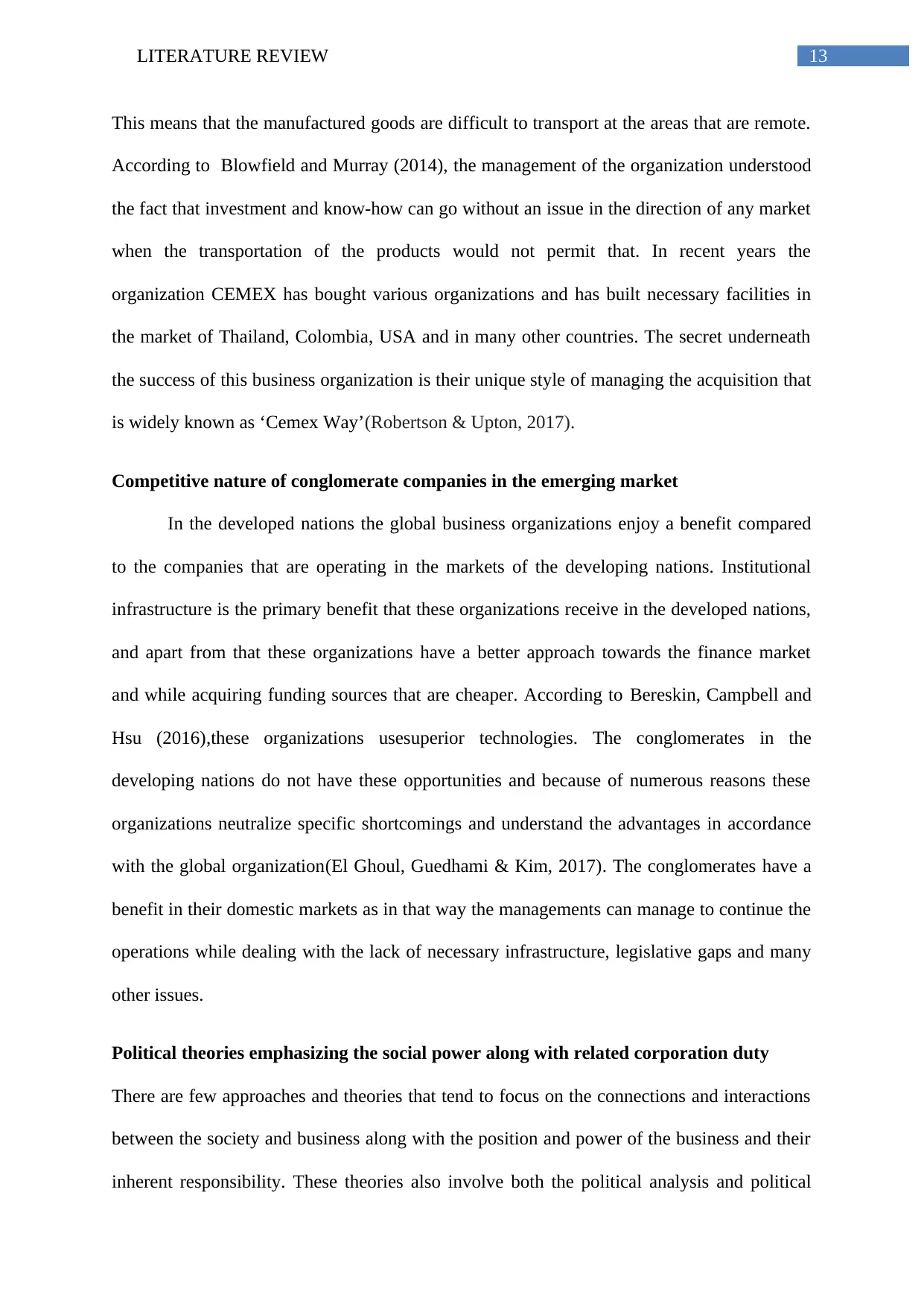
13LITERATURE REVIEW
This means that the manufactured goods are difficult to transport at the areas that are remote.
According to Blowfield and Murray (2014), the management of the organization understood
the fact that investment and know-how can go without an issue in the direction of any market
when the transportation of the products would not permit that. In recent years the
organization CEMEX has bought various organizations and has built necessary facilities in
the market of Thailand, Colombia, USA and in many other countries. The secret underneath
the success of this business organization is their unique style of managing the acquisition that
is widely known as ‘Cemex Way’(Robertson & Upton, 2017).
Competitive nature of conglomerate companies in the emerging market
In the developed nations the global business organizations enjoy a benefit compared
to the companies that are operating in the markets of the developing nations. Institutional
infrastructure is the primary benefit that these organizations receive in the developed nations,
and apart from that these organizations have a better approach towards the finance market
and while acquiring funding sources that are cheaper. According to Bereskin, Campbell and
Hsu (2016),these organizations usesuperior technologies. The conglomerates in the
developing nations do not have these opportunities and because of numerous reasons these
organizations neutralize specific shortcomings and understand the advantages in accordance
with the global organization(El Ghoul, Guedhami & Kim, 2017). The conglomerates have a
benefit in their domestic markets as in that way the managements can manage to continue the
operations while dealing with the lack of necessary infrastructure, legislative gaps and many
other issues.
Political theories emphasizing the social power along with related corporation duty
There are few approaches and theories that tend to focus on the connections and interactions
between the society and business along with the position and power of the business and their
inherent responsibility. These theories also involve both the political analysis and political
This means that the manufactured goods are difficult to transport at the areas that are remote.
According to Blowfield and Murray (2014), the management of the organization understood
the fact that investment and know-how can go without an issue in the direction of any market
when the transportation of the products would not permit that. In recent years the
organization CEMEX has bought various organizations and has built necessary facilities in
the market of Thailand, Colombia, USA and in many other countries. The secret underneath
the success of this business organization is their unique style of managing the acquisition that
is widely known as ‘Cemex Way’(Robertson & Upton, 2017).
Competitive nature of conglomerate companies in the emerging market
In the developed nations the global business organizations enjoy a benefit compared
to the companies that are operating in the markets of the developing nations. Institutional
infrastructure is the primary benefit that these organizations receive in the developed nations,
and apart from that these organizations have a better approach towards the finance market
and while acquiring funding sources that are cheaper. According to Bereskin, Campbell and
Hsu (2016),these organizations usesuperior technologies. The conglomerates in the
developing nations do not have these opportunities and because of numerous reasons these
organizations neutralize specific shortcomings and understand the advantages in accordance
with the global organization(El Ghoul, Guedhami & Kim, 2017). The conglomerates have a
benefit in their domestic markets as in that way the managements can manage to continue the
operations while dealing with the lack of necessary infrastructure, legislative gaps and many
other issues.
Political theories emphasizing the social power along with related corporation duty
There are few approaches and theories that tend to focus on the connections and interactions
between the society and business along with the position and power of the business and their
inherent responsibility. These theories also involve both the political analysis and political
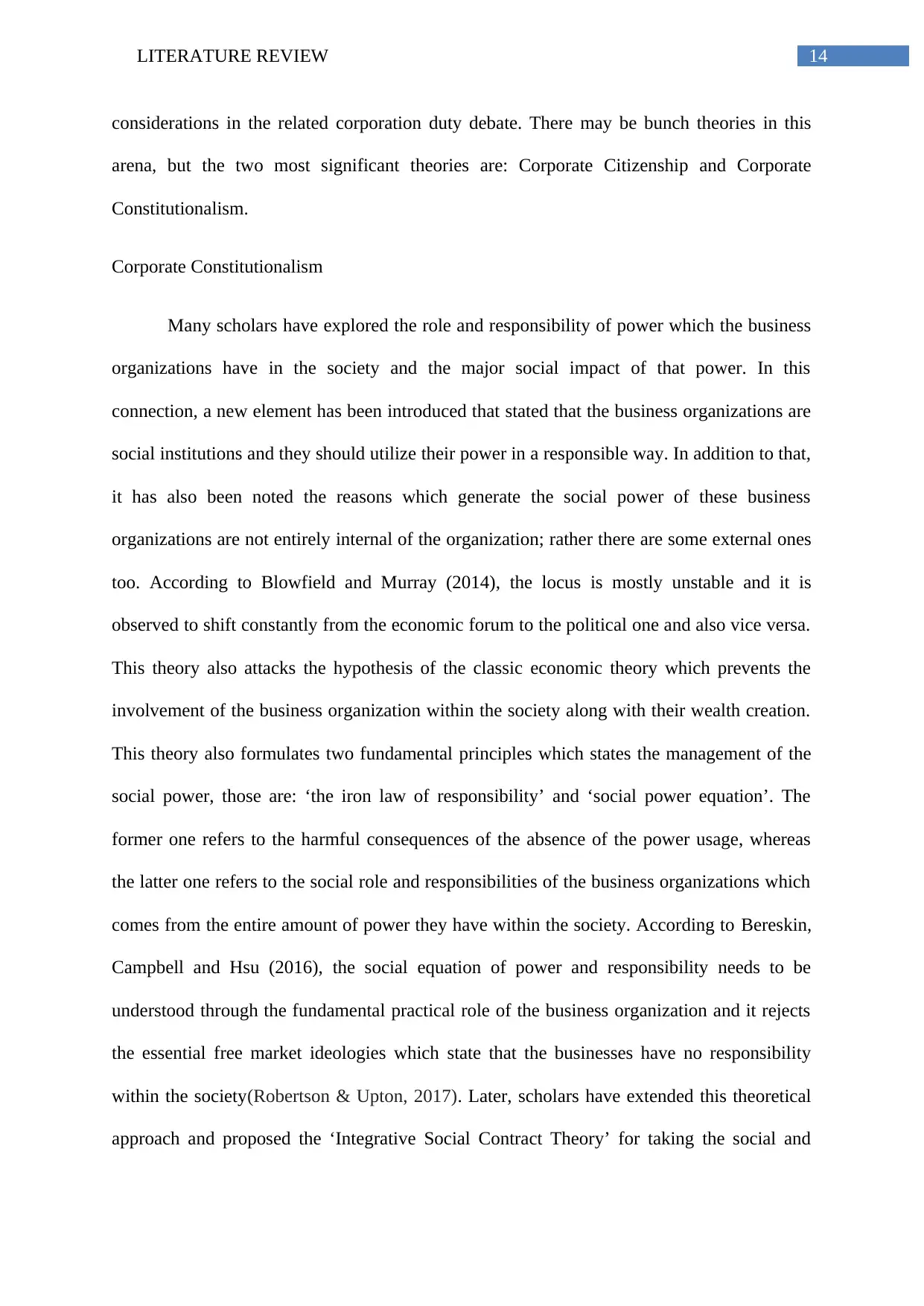
14LITERATURE REVIEW
considerations in the related corporation duty debate. There may be bunch theories in this
arena, but the two most significant theories are: Corporate Citizenship and Corporate
Constitutionalism.
Corporate Constitutionalism
Many scholars have explored the role and responsibility of power which the business
organizations have in the society and the major social impact of that power. In this
connection, a new element has been introduced that stated that the business organizations are
social institutions and they should utilize their power in a responsible way. In addition to that,
it has also been noted the reasons which generate the social power of these business
organizations are not entirely internal of the organization; rather there are some external ones
too. According to Blowfield and Murray (2014), the locus is mostly unstable and it is
observed to shift constantly from the economic forum to the political one and also vice versa.
This theory also attacks the hypothesis of the classic economic theory which prevents the
involvement of the business organization within the society along with their wealth creation.
This theory also formulates two fundamental principles which states the management of the
social power, those are: ‘the iron law of responsibility’ and ‘social power equation’. The
former one refers to the harmful consequences of the absence of the power usage, whereas
the latter one refers to the social role and responsibilities of the business organizations which
comes from the entire amount of power they have within the society. According to Bereskin,
Campbell and Hsu (2016), the social equation of power and responsibility needs to be
understood through the fundamental practical role of the business organization and it rejects
the essential free market ideologies which state that the businesses have no responsibility
within the society(Robertson & Upton, 2017). Later, scholars have extended this theoretical
approach and proposed the ‘Integrative Social Contract Theory’ for taking the social and
considerations in the related corporation duty debate. There may be bunch theories in this
arena, but the two most significant theories are: Corporate Citizenship and Corporate
Constitutionalism.
Corporate Constitutionalism
Many scholars have explored the role and responsibility of power which the business
organizations have in the society and the major social impact of that power. In this
connection, a new element has been introduced that stated that the business organizations are
social institutions and they should utilize their power in a responsible way. In addition to that,
it has also been noted the reasons which generate the social power of these business
organizations are not entirely internal of the organization; rather there are some external ones
too. According to Blowfield and Murray (2014), the locus is mostly unstable and it is
observed to shift constantly from the economic forum to the political one and also vice versa.
This theory also attacks the hypothesis of the classic economic theory which prevents the
involvement of the business organization within the society along with their wealth creation.
This theory also formulates two fundamental principles which states the management of the
social power, those are: ‘the iron law of responsibility’ and ‘social power equation’. The
former one refers to the harmful consequences of the absence of the power usage, whereas
the latter one refers to the social role and responsibilities of the business organizations which
comes from the entire amount of power they have within the society. According to Bereskin,
Campbell and Hsu (2016), the social equation of power and responsibility needs to be
understood through the fundamental practical role of the business organization and it rejects
the essential free market ideologies which state that the businesses have no responsibility
within the society(Robertson & Upton, 2017). Later, scholars have extended this theoretical
approach and proposed the ‘Integrative Social Contract Theory’ for taking the social and
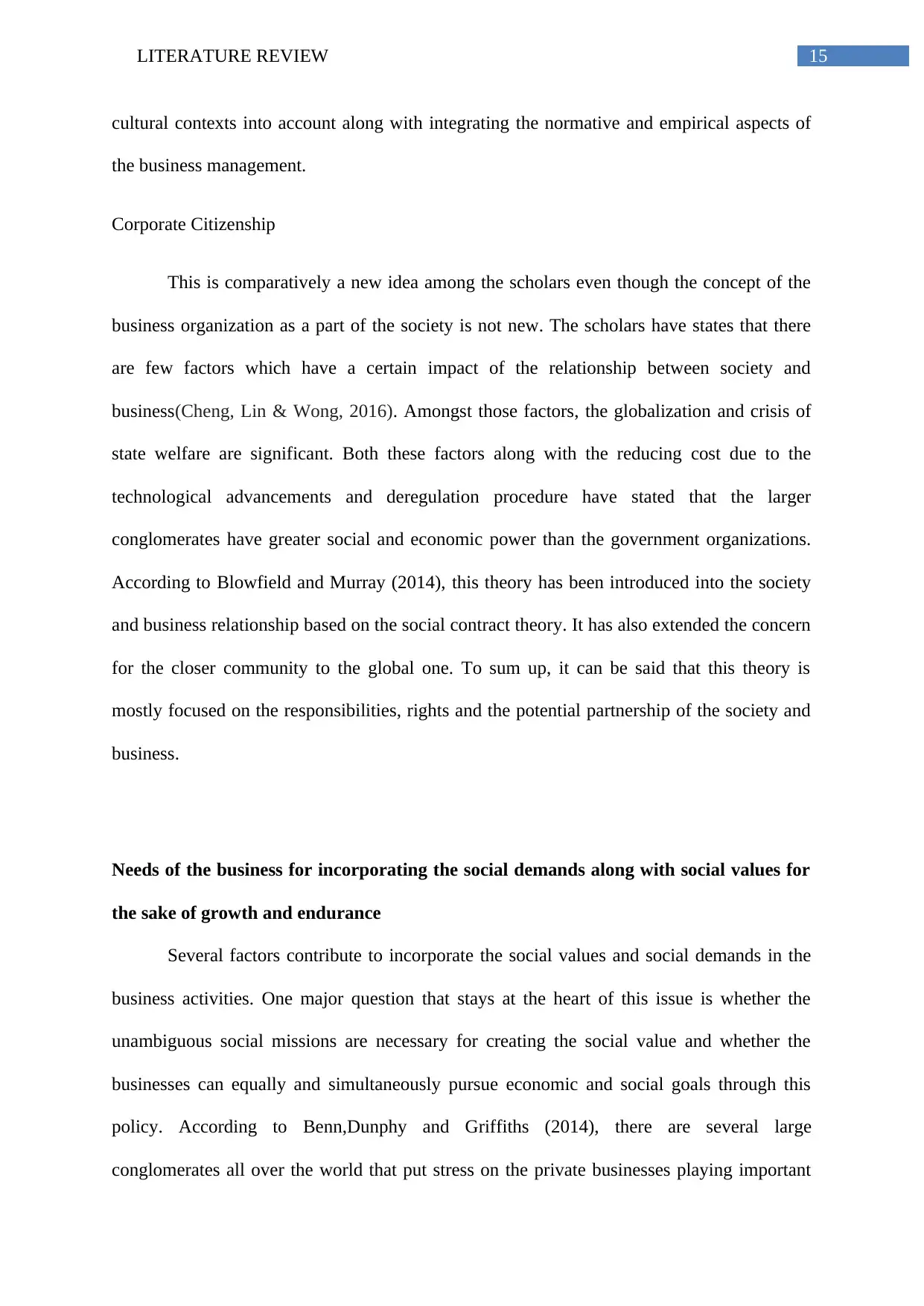
15LITERATURE REVIEW
cultural contexts into account along with integrating the normative and empirical aspects of
the business management.
Corporate Citizenship
This is comparatively a new idea among the scholars even though the concept of the
business organization as a part of the society is not new. The scholars have states that there
are few factors which have a certain impact of the relationship between society and
business(Cheng, Lin & Wong, 2016). Amongst those factors, the globalization and crisis of
state welfare are significant. Both these factors along with the reducing cost due to the
technological advancements and deregulation procedure have stated that the larger
conglomerates have greater social and economic power than the government organizations.
According to Blowfield and Murray (2014), this theory has been introduced into the society
and business relationship based on the social contract theory. It has also extended the concern
for the closer community to the global one. To sum up, it can be said that this theory is
mostly focused on the responsibilities, rights and the potential partnership of the society and
business.
Needs of the business for incorporating the social demands along with social values for
the sake of growth and endurance
Several factors contribute to incorporate the social values and social demands in the
business activities. One major question that stays at the heart of this issue is whether the
unambiguous social missions are necessary for creating the social value and whether the
businesses can equally and simultaneously pursue economic and social goals through this
policy. According to Benn,Dunphy and Griffiths (2014), there are several large
conglomerates all over the world that put stress on the private businesses playing important
cultural contexts into account along with integrating the normative and empirical aspects of
the business management.
Corporate Citizenship
This is comparatively a new idea among the scholars even though the concept of the
business organization as a part of the society is not new. The scholars have states that there
are few factors which have a certain impact of the relationship between society and
business(Cheng, Lin & Wong, 2016). Amongst those factors, the globalization and crisis of
state welfare are significant. Both these factors along with the reducing cost due to the
technological advancements and deregulation procedure have stated that the larger
conglomerates have greater social and economic power than the government organizations.
According to Blowfield and Murray (2014), this theory has been introduced into the society
and business relationship based on the social contract theory. It has also extended the concern
for the closer community to the global one. To sum up, it can be said that this theory is
mostly focused on the responsibilities, rights and the potential partnership of the society and
business.
Needs of the business for incorporating the social demands along with social values for
the sake of growth and endurance
Several factors contribute to incorporate the social values and social demands in the
business activities. One major question that stays at the heart of this issue is whether the
unambiguous social missions are necessary for creating the social value and whether the
businesses can equally and simultaneously pursue economic and social goals through this
policy. According to Benn,Dunphy and Griffiths (2014), there are several large
conglomerates all over the world that put stress on the private businesses playing important
Secure Best Marks with AI Grader
Need help grading? Try our AI Grader for instant feedback on your assignments.
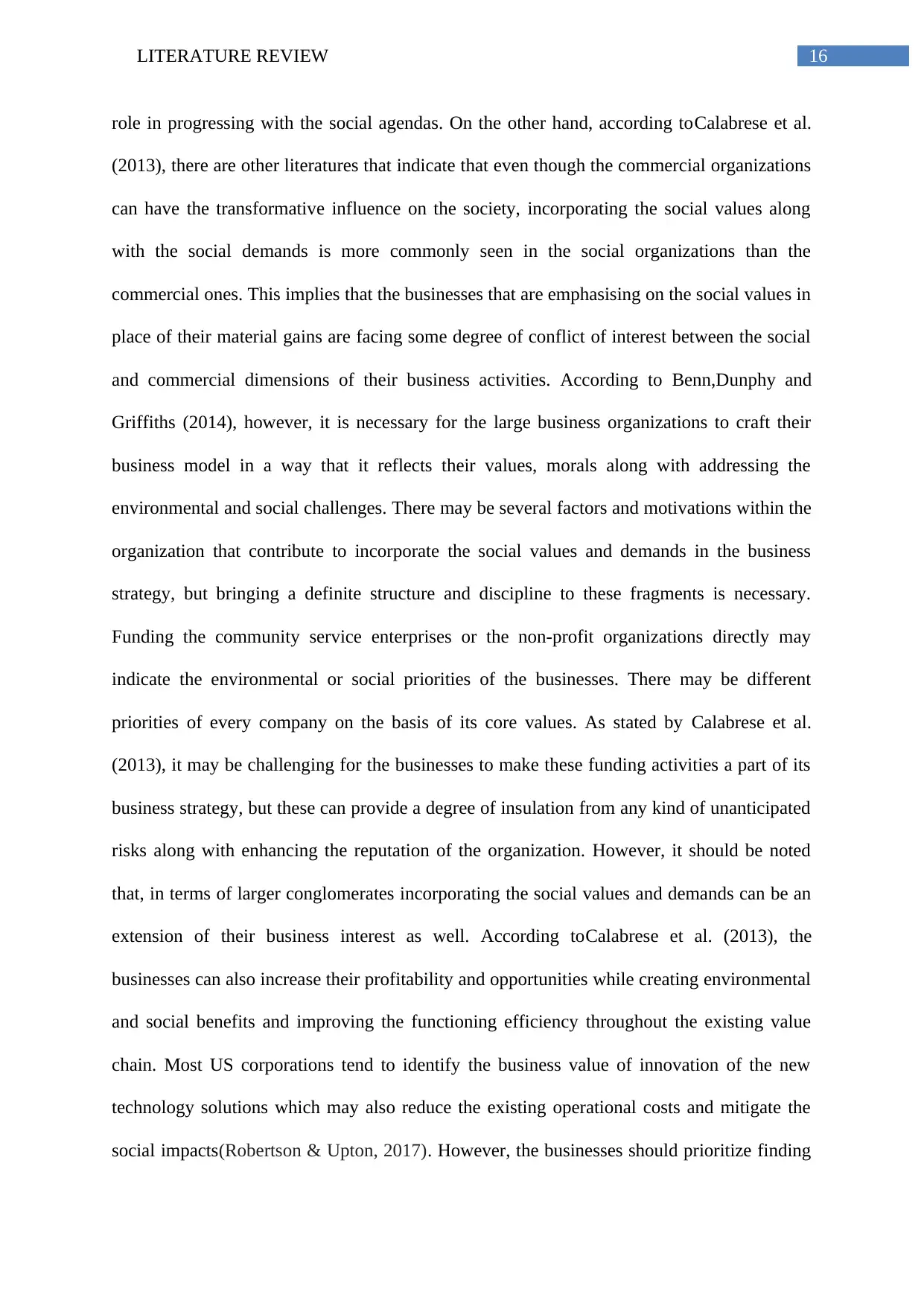
16LITERATURE REVIEW
role in progressing with the social agendas. On the other hand, according toCalabrese et al.
(2013), there are other literatures that indicate that even though the commercial organizations
can have the transformative influence on the society, incorporating the social values along
with the social demands is more commonly seen in the social organizations than the
commercial ones. This implies that the businesses that are emphasising on the social values in
place of their material gains are facing some degree of conflict of interest between the social
and commercial dimensions of their business activities. According to Benn,Dunphy and
Griffiths (2014), however, it is necessary for the large business organizations to craft their
business model in a way that it reflects their values, morals along with addressing the
environmental and social challenges. There may be several factors and motivations within the
organization that contribute to incorporate the social values and demands in the business
strategy, but bringing a definite structure and discipline to these fragments is necessary.
Funding the community service enterprises or the non-profit organizations directly may
indicate the environmental or social priorities of the businesses. There may be different
priorities of every company on the basis of its core values. As stated by Calabrese et al.
(2013), it may be challenging for the businesses to make these funding activities a part of its
business strategy, but these can provide a degree of insulation from any kind of unanticipated
risks along with enhancing the reputation of the organization. However, it should be noted
that, in terms of larger conglomerates incorporating the social values and demands can be an
extension of their business interest as well. According toCalabrese et al. (2013), the
businesses can also increase their profitability and opportunities while creating environmental
and social benefits and improving the functioning efficiency throughout the existing value
chain. Most US corporations tend to identify the business value of innovation of the new
technology solutions which may also reduce the existing operational costs and mitigate the
social impacts(Robertson & Upton, 2017). However, the businesses should prioritize finding
role in progressing with the social agendas. On the other hand, according toCalabrese et al.
(2013), there are other literatures that indicate that even though the commercial organizations
can have the transformative influence on the society, incorporating the social values along
with the social demands is more commonly seen in the social organizations than the
commercial ones. This implies that the businesses that are emphasising on the social values in
place of their material gains are facing some degree of conflict of interest between the social
and commercial dimensions of their business activities. According to Benn,Dunphy and
Griffiths (2014), however, it is necessary for the large business organizations to craft their
business model in a way that it reflects their values, morals along with addressing the
environmental and social challenges. There may be several factors and motivations within the
organization that contribute to incorporate the social values and demands in the business
strategy, but bringing a definite structure and discipline to these fragments is necessary.
Funding the community service enterprises or the non-profit organizations directly may
indicate the environmental or social priorities of the businesses. There may be different
priorities of every company on the basis of its core values. As stated by Calabrese et al.
(2013), it may be challenging for the businesses to make these funding activities a part of its
business strategy, but these can provide a degree of insulation from any kind of unanticipated
risks along with enhancing the reputation of the organization. However, it should be noted
that, in terms of larger conglomerates incorporating the social values and demands can be an
extension of their business interest as well. According toCalabrese et al. (2013), the
businesses can also increase their profitability and opportunities while creating environmental
and social benefits and improving the functioning efficiency throughout the existing value
chain. Most US corporations tend to identify the business value of innovation of the new
technology solutions which may also reduce the existing operational costs and mitigate the
social impacts(Robertson & Upton, 2017). However, the businesses should prioritize finding
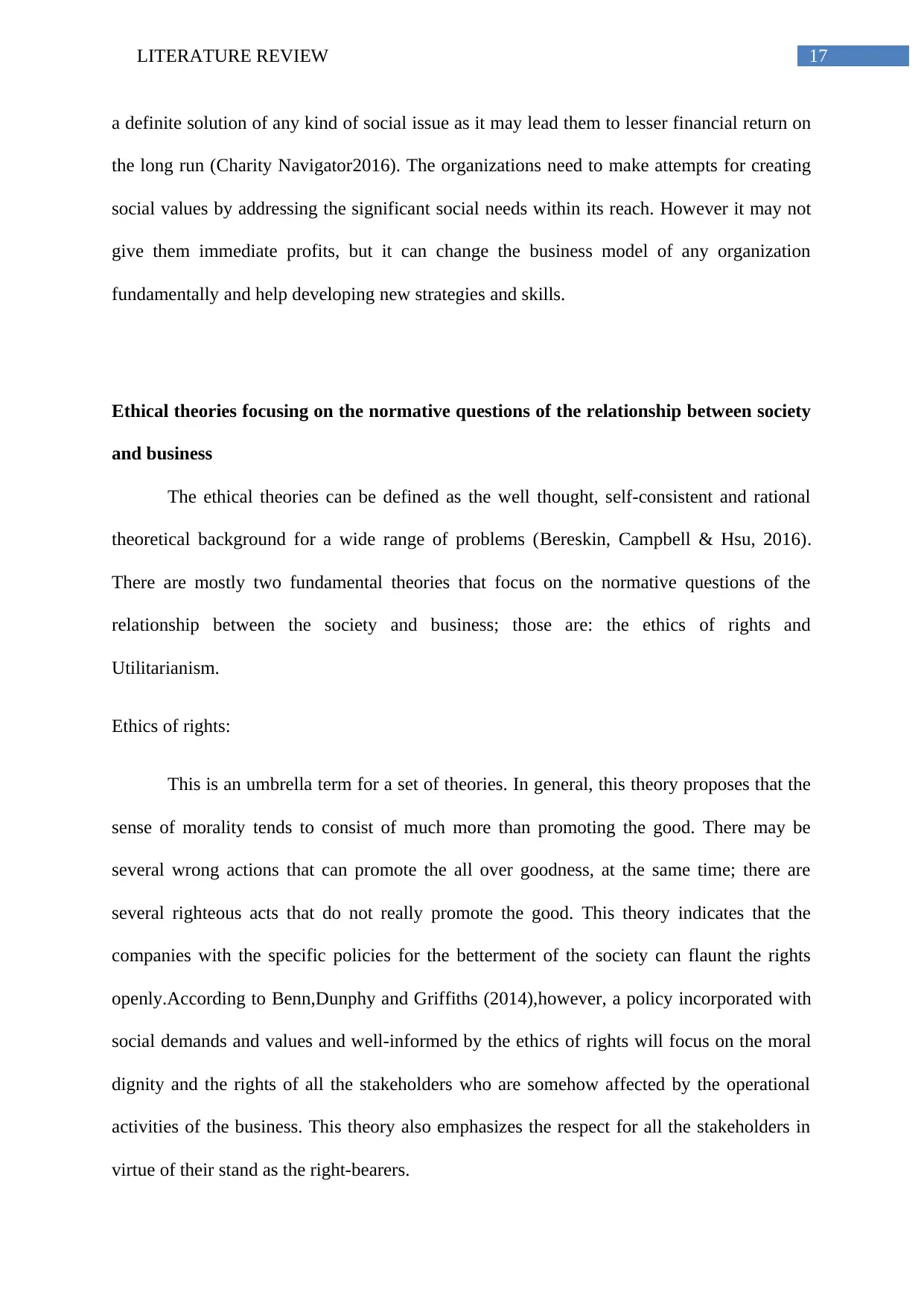
17LITERATURE REVIEW
a definite solution of any kind of social issue as it may lead them to lesser financial return on
the long run (Charity Navigator2016). The organizations need to make attempts for creating
social values by addressing the significant social needs within its reach. However it may not
give them immediate profits, but it can change the business model of any organization
fundamentally and help developing new strategies and skills.
Ethical theories focusing on the normative questions of the relationship between society
and business
The ethical theories can be defined as the well thought, self-consistent and rational
theoretical background for a wide range of problems (Bereskin, Campbell & Hsu, 2016).
There are mostly two fundamental theories that focus on the normative questions of the
relationship between the society and business; those are: the ethics of rights and
Utilitarianism.
Ethics of rights:
This is an umbrella term for a set of theories. In general, this theory proposes that the
sense of morality tends to consist of much more than promoting the good. There may be
several wrong actions that can promote the all over goodness, at the same time; there are
several righteous acts that do not really promote the good. This theory indicates that the
companies with the specific policies for the betterment of the society can flaunt the rights
openly.According to Benn,Dunphy and Griffiths (2014),however, a policy incorporated with
social demands and values and well-informed by the ethics of rights will focus on the moral
dignity and the rights of all the stakeholders who are somehow affected by the operational
activities of the business. This theory also emphasizes the respect for all the stakeholders in
virtue of their stand as the right-bearers.
a definite solution of any kind of social issue as it may lead them to lesser financial return on
the long run (Charity Navigator2016). The organizations need to make attempts for creating
social values by addressing the significant social needs within its reach. However it may not
give them immediate profits, but it can change the business model of any organization
fundamentally and help developing new strategies and skills.
Ethical theories focusing on the normative questions of the relationship between society
and business
The ethical theories can be defined as the well thought, self-consistent and rational
theoretical background for a wide range of problems (Bereskin, Campbell & Hsu, 2016).
There are mostly two fundamental theories that focus on the normative questions of the
relationship between the society and business; those are: the ethics of rights and
Utilitarianism.
Ethics of rights:
This is an umbrella term for a set of theories. In general, this theory proposes that the
sense of morality tends to consist of much more than promoting the good. There may be
several wrong actions that can promote the all over goodness, at the same time; there are
several righteous acts that do not really promote the good. This theory indicates that the
companies with the specific policies for the betterment of the society can flaunt the rights
openly.According to Benn,Dunphy and Griffiths (2014),however, a policy incorporated with
social demands and values and well-informed by the ethics of rights will focus on the moral
dignity and the rights of all the stakeholders who are somehow affected by the operational
activities of the business. This theory also emphasizes the respect for all the stakeholders in
virtue of their stand as the right-bearers.
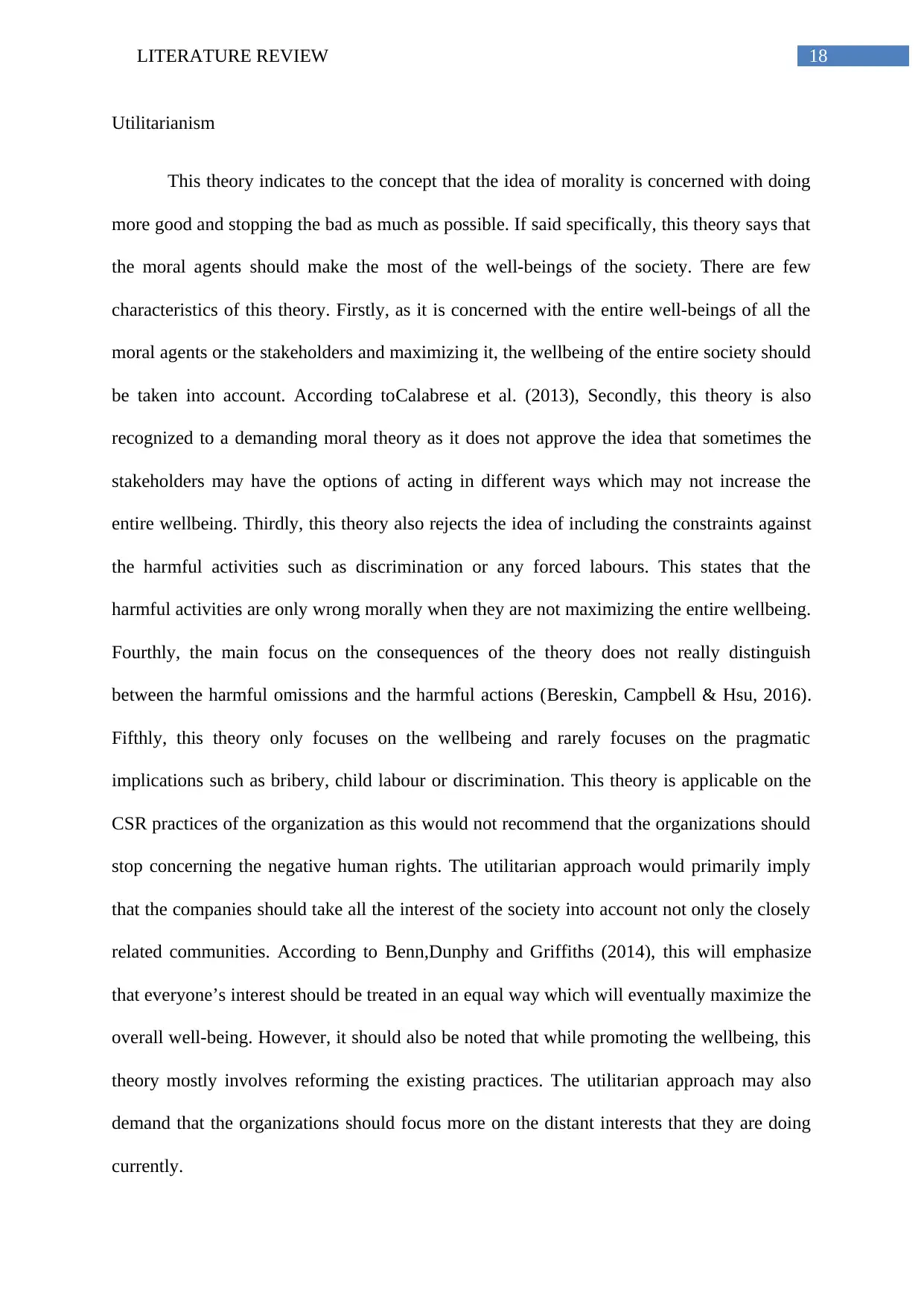
18LITERATURE REVIEW
Utilitarianism
This theory indicates to the concept that the idea of morality is concerned with doing
more good and stopping the bad as much as possible. If said specifically, this theory says that
the moral agents should make the most of the well-beings of the society. There are few
characteristics of this theory. Firstly, as it is concerned with the entire well-beings of all the
moral agents or the stakeholders and maximizing it, the wellbeing of the entire society should
be taken into account. According toCalabrese et al. (2013), Secondly, this theory is also
recognized to a demanding moral theory as it does not approve the idea that sometimes the
stakeholders may have the options of acting in different ways which may not increase the
entire wellbeing. Thirdly, this theory also rejects the idea of including the constraints against
the harmful activities such as discrimination or any forced labours. This states that the
harmful activities are only wrong morally when they are not maximizing the entire wellbeing.
Fourthly, the main focus on the consequences of the theory does not really distinguish
between the harmful omissions and the harmful actions (Bereskin, Campbell & Hsu, 2016).
Fifthly, this theory only focuses on the wellbeing and rarely focuses on the pragmatic
implications such as bribery, child labour or discrimination. This theory is applicable on the
CSR practices of the organization as this would not recommend that the organizations should
stop concerning the negative human rights. The utilitarian approach would primarily imply
that the companies should take all the interest of the society into account not only the closely
related communities. According to Benn,Dunphy and Griffiths (2014), this will emphasize
that everyone’s interest should be treated in an equal way which will eventually maximize the
overall well-being. However, it should also be noted that while promoting the wellbeing, this
theory mostly involves reforming the existing practices. The utilitarian approach may also
demand that the organizations should focus more on the distant interests that they are doing
currently.
Utilitarianism
This theory indicates to the concept that the idea of morality is concerned with doing
more good and stopping the bad as much as possible. If said specifically, this theory says that
the moral agents should make the most of the well-beings of the society. There are few
characteristics of this theory. Firstly, as it is concerned with the entire well-beings of all the
moral agents or the stakeholders and maximizing it, the wellbeing of the entire society should
be taken into account. According toCalabrese et al. (2013), Secondly, this theory is also
recognized to a demanding moral theory as it does not approve the idea that sometimes the
stakeholders may have the options of acting in different ways which may not increase the
entire wellbeing. Thirdly, this theory also rejects the idea of including the constraints against
the harmful activities such as discrimination or any forced labours. This states that the
harmful activities are only wrong morally when they are not maximizing the entire wellbeing.
Fourthly, the main focus on the consequences of the theory does not really distinguish
between the harmful omissions and the harmful actions (Bereskin, Campbell & Hsu, 2016).
Fifthly, this theory only focuses on the wellbeing and rarely focuses on the pragmatic
implications such as bribery, child labour or discrimination. This theory is applicable on the
CSR practices of the organization as this would not recommend that the organizations should
stop concerning the negative human rights. The utilitarian approach would primarily imply
that the companies should take all the interest of the society into account not only the closely
related communities. According to Benn,Dunphy and Griffiths (2014), this will emphasize
that everyone’s interest should be treated in an equal way which will eventually maximize the
overall well-being. However, it should also be noted that while promoting the wellbeing, this
theory mostly involves reforming the existing practices. The utilitarian approach may also
demand that the organizations should focus more on the distant interests that they are doing
currently.
Paraphrase This Document
Need a fresh take? Get an instant paraphrase of this document with our AI Paraphraser
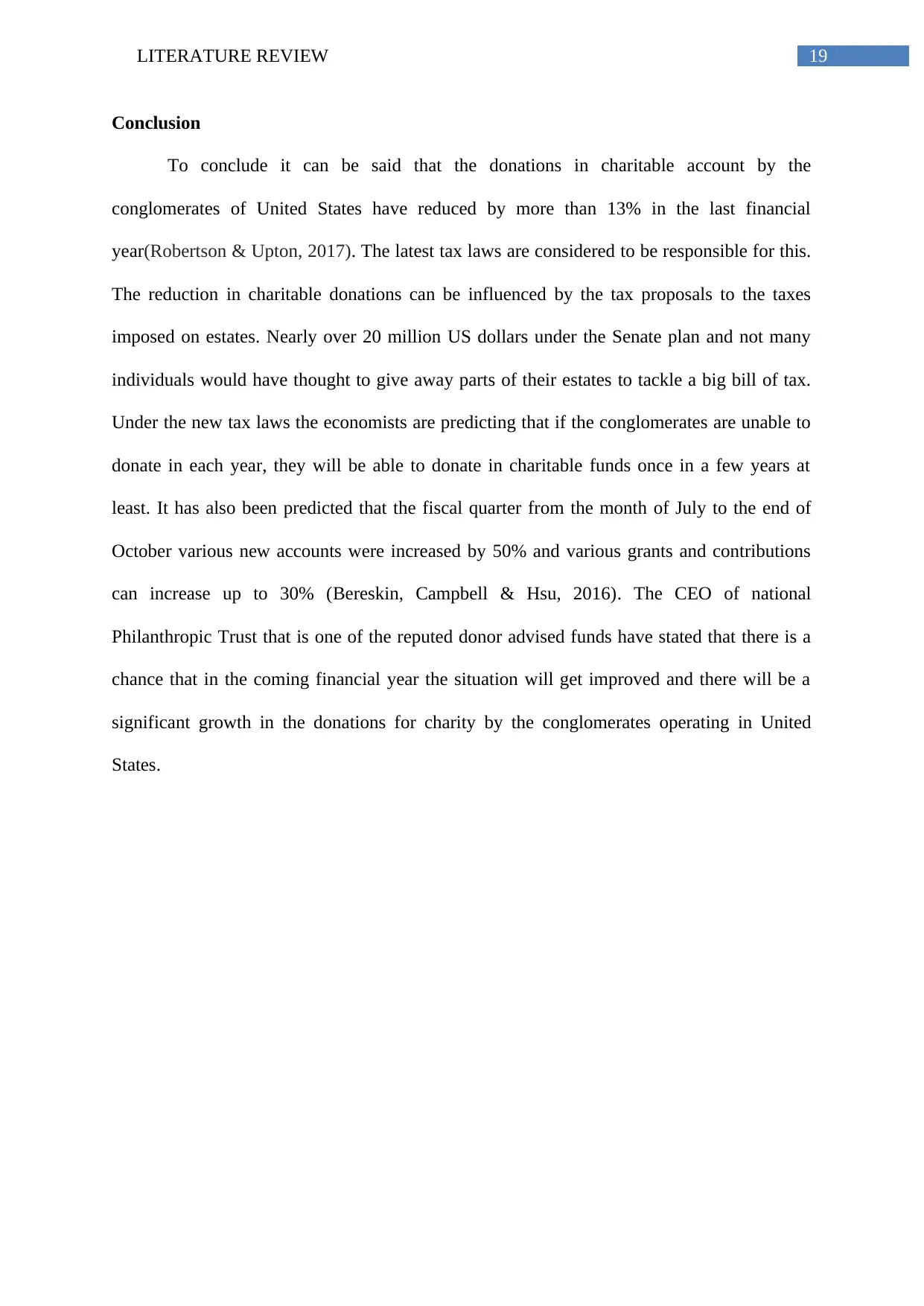
19LITERATURE REVIEW
Conclusion
To conclude it can be said that the donations in charitable account by the
conglomerates of United States have reduced by more than 13% in the last financial
year(Robertson & Upton, 2017). The latest tax laws are considered to be responsible for this.
The reduction in charitable donations can be influenced by the tax proposals to the taxes
imposed on estates. Nearly over 20 million US dollars under the Senate plan and not many
individuals would have thought to give away parts of their estates to tackle a big bill of tax.
Under the new tax laws the economists are predicting that if the conglomerates are unable to
donate in each year, they will be able to donate in charitable funds once in a few years at
least. It has also been predicted that the fiscal quarter from the month of July to the end of
October various new accounts were increased by 50% and various grants and contributions
can increase up to 30% (Bereskin, Campbell & Hsu, 2016). The CEO of national
Philanthropic Trust that is one of the reputed donor advised funds have stated that there is a
chance that in the coming financial year the situation will get improved and there will be a
significant growth in the donations for charity by the conglomerates operating in United
States.
Conclusion
To conclude it can be said that the donations in charitable account by the
conglomerates of United States have reduced by more than 13% in the last financial
year(Robertson & Upton, 2017). The latest tax laws are considered to be responsible for this.
The reduction in charitable donations can be influenced by the tax proposals to the taxes
imposed on estates. Nearly over 20 million US dollars under the Senate plan and not many
individuals would have thought to give away parts of their estates to tackle a big bill of tax.
Under the new tax laws the economists are predicting that if the conglomerates are unable to
donate in each year, they will be able to donate in charitable funds once in a few years at
least. It has also been predicted that the fiscal quarter from the month of July to the end of
October various new accounts were increased by 50% and various grants and contributions
can increase up to 30% (Bereskin, Campbell & Hsu, 2016). The CEO of national
Philanthropic Trust that is one of the reputed donor advised funds have stated that there is a
chance that in the coming financial year the situation will get improved and there will be a
significant growth in the donations for charity by the conglomerates operating in United
States.
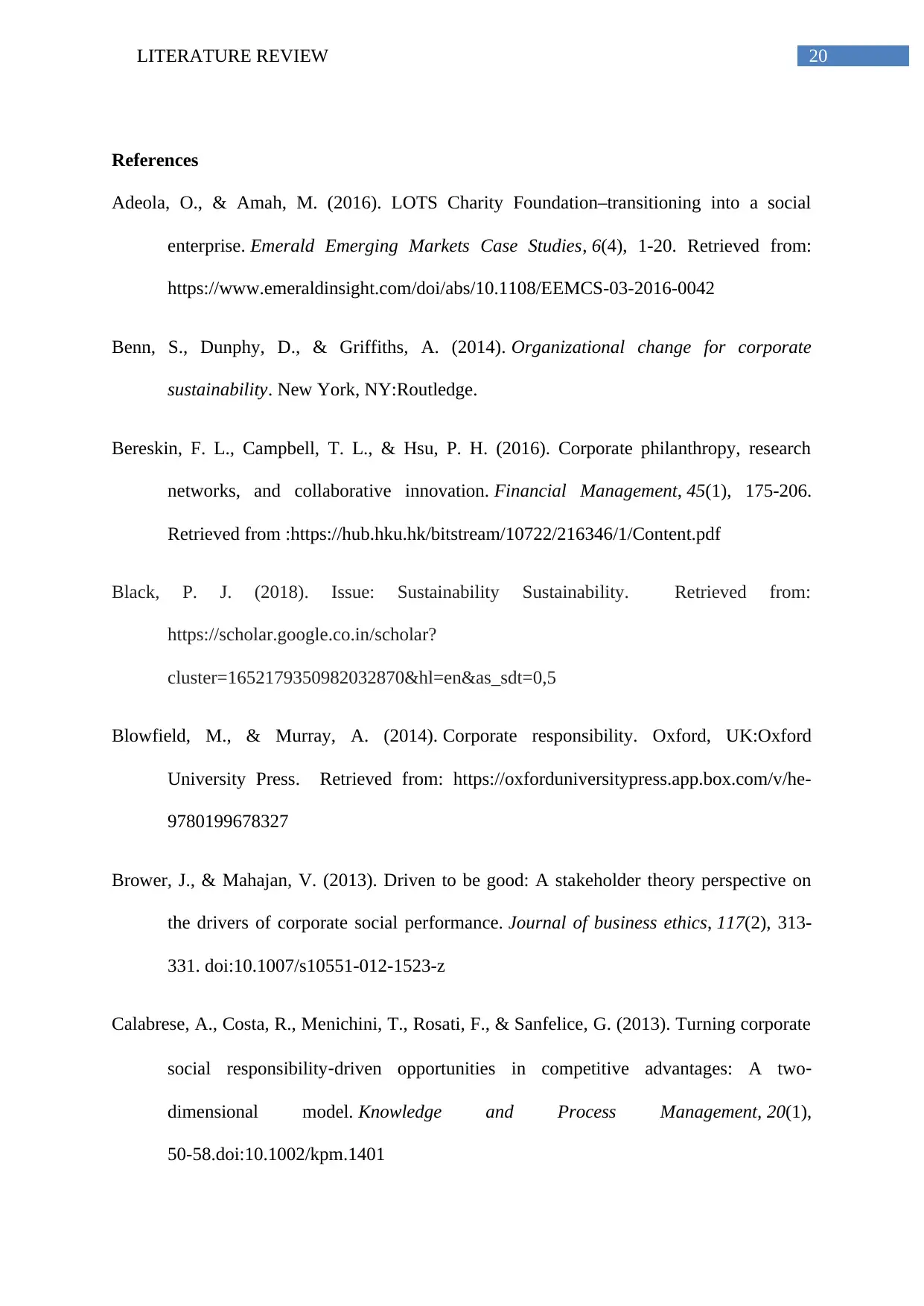
20LITERATURE REVIEW
References
Adeola, O., & Amah, M. (2016). LOTS Charity Foundation–transitioning into a social
enterprise. Emerald Emerging Markets Case Studies, 6(4), 1-20. Retrieved from:
https://www.emeraldinsight.com/doi/abs/10.1108/EEMCS-03-2016-0042
Benn, S., Dunphy, D., & Griffiths, A. (2014). Organizational change for corporate
sustainability. New York, NY:Routledge.
Bereskin, F. L., Campbell, T. L., & Hsu, P. H. (2016). Corporate philanthropy, research
networks, and collaborative innovation. Financial Management, 45(1), 175-206.
Retrieved from :https://hub.hku.hk/bitstream/10722/216346/1/Content.pdf
Black, P. J. (2018). Issue: Sustainability Sustainability. Retrieved from:
https://scholar.google.co.in/scholar?
cluster=1652179350982032870&hl=en&as_sdt=0,5
Blowfield, M., & Murray, A. (2014). Corporate responsibility. Oxford, UK:Oxford
University Press. Retrieved from: https://oxforduniversitypress.app.box.com/v/he-
9780199678327
Brower, J., & Mahajan, V. (2013). Driven to be good: A stakeholder theory perspective on
the drivers of corporate social performance. Journal of business ethics, 117(2), 313-
331. doi:10.1007/s10551-012-1523-z
Calabrese, A., Costa, R., Menichini, T., Rosati, F., & Sanfelice, G. (2013). Turning corporate
social responsibility‐driven opportunities in competitive advantages: A two‐
dimensional model. Knowledge and Process Management, 20(1),
50-58.doi:10.1002/kpm.1401
References
Adeola, O., & Amah, M. (2016). LOTS Charity Foundation–transitioning into a social
enterprise. Emerald Emerging Markets Case Studies, 6(4), 1-20. Retrieved from:
https://www.emeraldinsight.com/doi/abs/10.1108/EEMCS-03-2016-0042
Benn, S., Dunphy, D., & Griffiths, A. (2014). Organizational change for corporate
sustainability. New York, NY:Routledge.
Bereskin, F. L., Campbell, T. L., & Hsu, P. H. (2016). Corporate philanthropy, research
networks, and collaborative innovation. Financial Management, 45(1), 175-206.
Retrieved from :https://hub.hku.hk/bitstream/10722/216346/1/Content.pdf
Black, P. J. (2018). Issue: Sustainability Sustainability. Retrieved from:
https://scholar.google.co.in/scholar?
cluster=1652179350982032870&hl=en&as_sdt=0,5
Blowfield, M., & Murray, A. (2014). Corporate responsibility. Oxford, UK:Oxford
University Press. Retrieved from: https://oxforduniversitypress.app.box.com/v/he-
9780199678327
Brower, J., & Mahajan, V. (2013). Driven to be good: A stakeholder theory perspective on
the drivers of corporate social performance. Journal of business ethics, 117(2), 313-
331. doi:10.1007/s10551-012-1523-z
Calabrese, A., Costa, R., Menichini, T., Rosati, F., & Sanfelice, G. (2013). Turning corporate
social responsibility‐driven opportunities in competitive advantages: A two‐
dimensional model. Knowledge and Process Management, 20(1),
50-58.doi:10.1002/kpm.1401
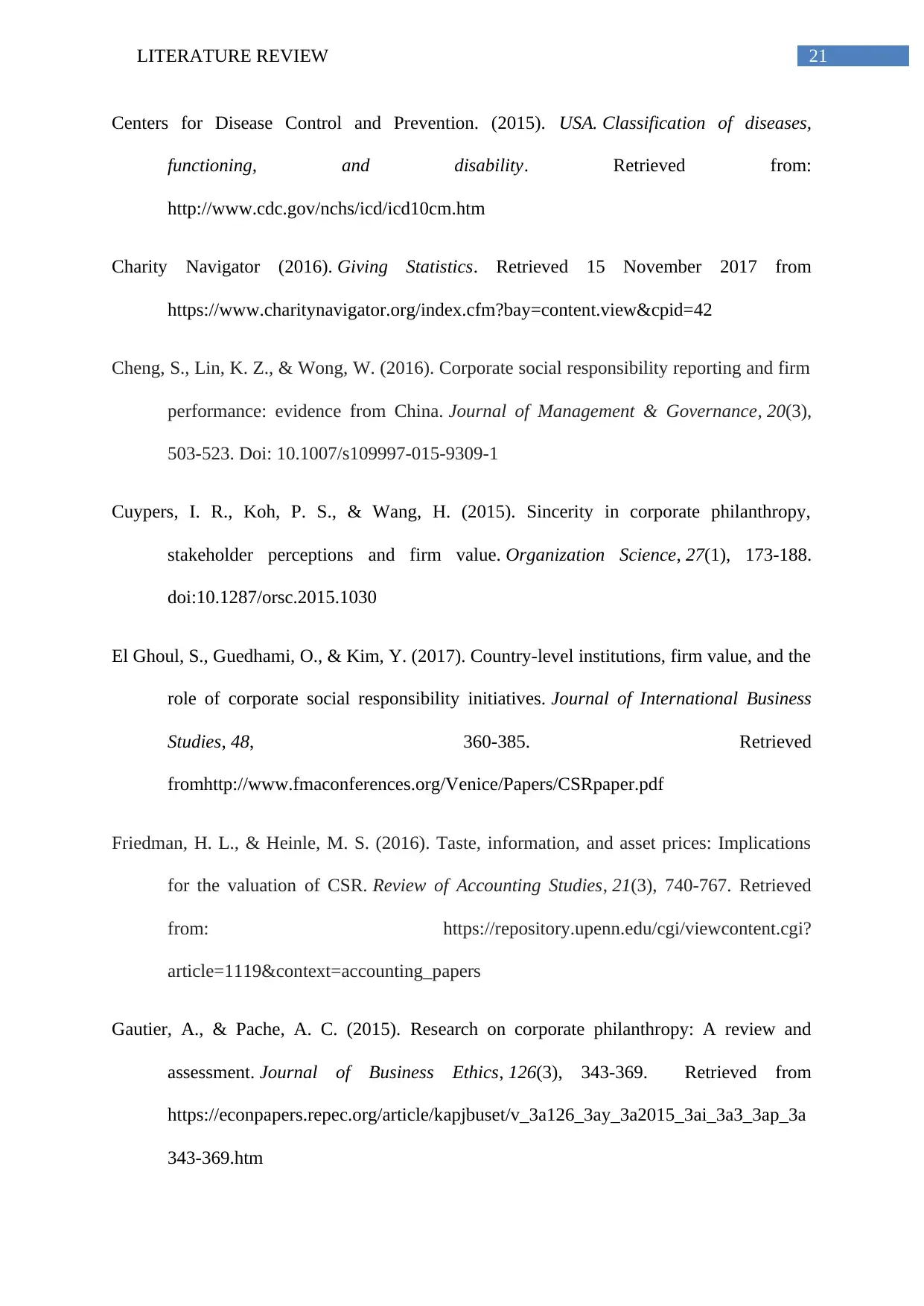
21LITERATURE REVIEW
Centers for Disease Control and Prevention. (2015). USA. Classification of diseases,
functioning, and disability. Retrieved from:
http://www.cdc.gov/nchs/icd/icd10cm.htm
Charity Navigator (2016). Giving Statistics. Retrieved 15 November 2017 from
https://www.charitynavigator.org/index.cfm?bay=content.view&cpid=42
Cheng, S., Lin, K. Z., & Wong, W. (2016). Corporate social responsibility reporting and firm
performance: evidence from China. Journal of Management & Governance, 20(3),
503-523. Doi: 10.1007/s109997-015-9309-1
Cuypers, I. R., Koh, P. S., & Wang, H. (2015). Sincerity in corporate philanthropy,
stakeholder perceptions and firm value. Organization Science, 27(1), 173-188.
doi:10.1287/orsc.2015.1030
El Ghoul, S., Guedhami, O., & Kim, Y. (2017). Country-level institutions, firm value, and the
role of corporate social responsibility initiatives. Journal of International Business
Studies, 48, 360-385. Retrieved
fromhttp://www.fmaconferences.org/Venice/Papers/CSRpaper.pdf
Friedman, H. L., & Heinle, M. S. (2016). Taste, information, and asset prices: Implications
for the valuation of CSR. Review of Accounting Studies, 21(3), 740-767. Retrieved
from: https://repository.upenn.edu/cgi/viewcontent.cgi?
article=1119&context=accounting_papers
Gautier, A., & Pache, A. C. (2015). Research on corporate philanthropy: A review and
assessment. Journal of Business Ethics, 126(3), 343-369. Retrieved from
https://econpapers.repec.org/article/kapjbuset/v_3a126_3ay_3a2015_3ai_3a3_3ap_3a
343-369.htm
Centers for Disease Control and Prevention. (2015). USA. Classification of diseases,
functioning, and disability. Retrieved from:
http://www.cdc.gov/nchs/icd/icd10cm.htm
Charity Navigator (2016). Giving Statistics. Retrieved 15 November 2017 from
https://www.charitynavigator.org/index.cfm?bay=content.view&cpid=42
Cheng, S., Lin, K. Z., & Wong, W. (2016). Corporate social responsibility reporting and firm
performance: evidence from China. Journal of Management & Governance, 20(3),
503-523. Doi: 10.1007/s109997-015-9309-1
Cuypers, I. R., Koh, P. S., & Wang, H. (2015). Sincerity in corporate philanthropy,
stakeholder perceptions and firm value. Organization Science, 27(1), 173-188.
doi:10.1287/orsc.2015.1030
El Ghoul, S., Guedhami, O., & Kim, Y. (2017). Country-level institutions, firm value, and the
role of corporate social responsibility initiatives. Journal of International Business
Studies, 48, 360-385. Retrieved
fromhttp://www.fmaconferences.org/Venice/Papers/CSRpaper.pdf
Friedman, H. L., & Heinle, M. S. (2016). Taste, information, and asset prices: Implications
for the valuation of CSR. Review of Accounting Studies, 21(3), 740-767. Retrieved
from: https://repository.upenn.edu/cgi/viewcontent.cgi?
article=1119&context=accounting_papers
Gautier, A., & Pache, A. C. (2015). Research on corporate philanthropy: A review and
assessment. Journal of Business Ethics, 126(3), 343-369. Retrieved from
https://econpapers.repec.org/article/kapjbuset/v_3a126_3ay_3a2015_3ai_3a3_3ap_3a
343-369.htm
Secure Best Marks with AI Grader
Need help grading? Try our AI Grader for instant feedback on your assignments.
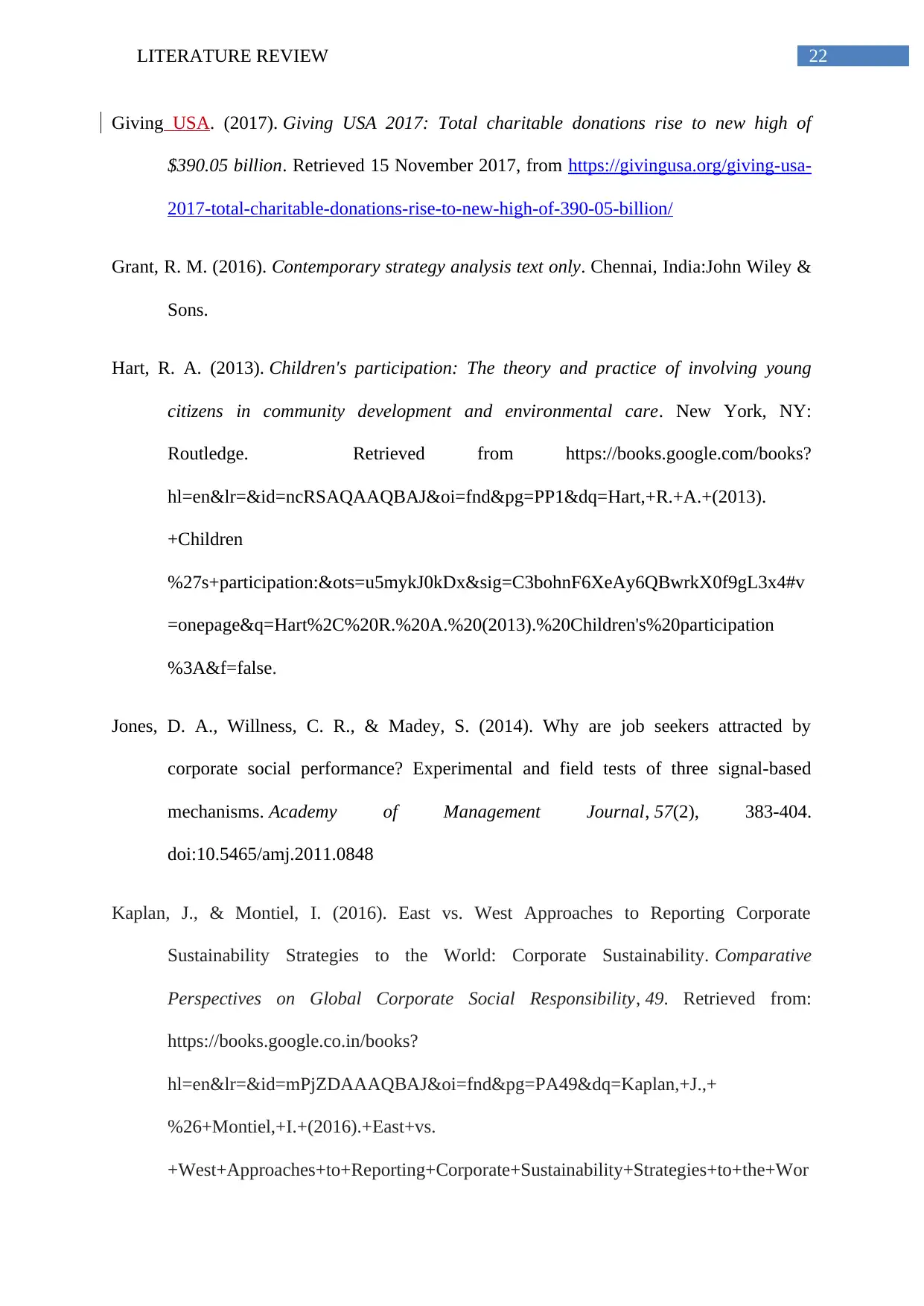
22LITERATURE REVIEW
Giving USA. (2017). Giving USA 2017: Total charitable donations rise to new high of
$390.05 billion. Retrieved 15 November 2017, from https://givingusa.org/giving-usa-
2017-total-charitable-donations-rise-to-new-high-of-390-05-billion/
Grant, R. M. (2016). Contemporary strategy analysis text only. Chennai, India:John Wiley &
Sons.
Hart, R. A. (2013). Children's participation: The theory and practice of involving young
citizens in community development and environmental care. New York, NY:
Routledge. Retrieved from https://books.google.com/books?
hl=en&lr=&id=ncRSAQAAQBAJ&oi=fnd&pg=PP1&dq=Hart,+R.+A.+(2013).
+Children
%27s+participation:&ots=u5mykJ0kDx&sig=C3bohnF6XeAy6QBwrkX0f9gL3x4#v
=onepage&q=Hart%2C%20R.%20A.%20(2013).%20Children's%20participation
%3A&f=false.
Jones, D. A., Willness, C. R., & Madey, S. (2014). Why are job seekers attracted by
corporate social performance? Experimental and field tests of three signal-based
mechanisms. Academy of Management Journal, 57(2), 383-404.
doi:10.5465/amj.2011.0848
Kaplan, J., & Montiel, I. (2016). East vs. West Approaches to Reporting Corporate
Sustainability Strategies to the World: Corporate Sustainability. Comparative
Perspectives on Global Corporate Social Responsibility, 49. Retrieved from:
https://books.google.co.in/books?
hl=en&lr=&id=mPjZDAAAQBAJ&oi=fnd&pg=PA49&dq=Kaplan,+J.,+
%26+Montiel,+I.+(2016).+East+vs.
+West+Approaches+to+Reporting+Corporate+Sustainability+Strategies+to+the+Wor
Giving USA. (2017). Giving USA 2017: Total charitable donations rise to new high of
$390.05 billion. Retrieved 15 November 2017, from https://givingusa.org/giving-usa-
2017-total-charitable-donations-rise-to-new-high-of-390-05-billion/
Grant, R. M. (2016). Contemporary strategy analysis text only. Chennai, India:John Wiley &
Sons.
Hart, R. A. (2013). Children's participation: The theory and practice of involving young
citizens in community development and environmental care. New York, NY:
Routledge. Retrieved from https://books.google.com/books?
hl=en&lr=&id=ncRSAQAAQBAJ&oi=fnd&pg=PP1&dq=Hart,+R.+A.+(2013).
+Children
%27s+participation:&ots=u5mykJ0kDx&sig=C3bohnF6XeAy6QBwrkX0f9gL3x4#v
=onepage&q=Hart%2C%20R.%20A.%20(2013).%20Children's%20participation
%3A&f=false.
Jones, D. A., Willness, C. R., & Madey, S. (2014). Why are job seekers attracted by
corporate social performance? Experimental and field tests of three signal-based
mechanisms. Academy of Management Journal, 57(2), 383-404.
doi:10.5465/amj.2011.0848
Kaplan, J., & Montiel, I. (2016). East vs. West Approaches to Reporting Corporate
Sustainability Strategies to the World: Corporate Sustainability. Comparative
Perspectives on Global Corporate Social Responsibility, 49. Retrieved from:
https://books.google.co.in/books?
hl=en&lr=&id=mPjZDAAAQBAJ&oi=fnd&pg=PA49&dq=Kaplan,+J.,+
%26+Montiel,+I.+(2016).+East+vs.
+West+Approaches+to+Reporting+Corporate+Sustainability+Strategies+to+the+Wor
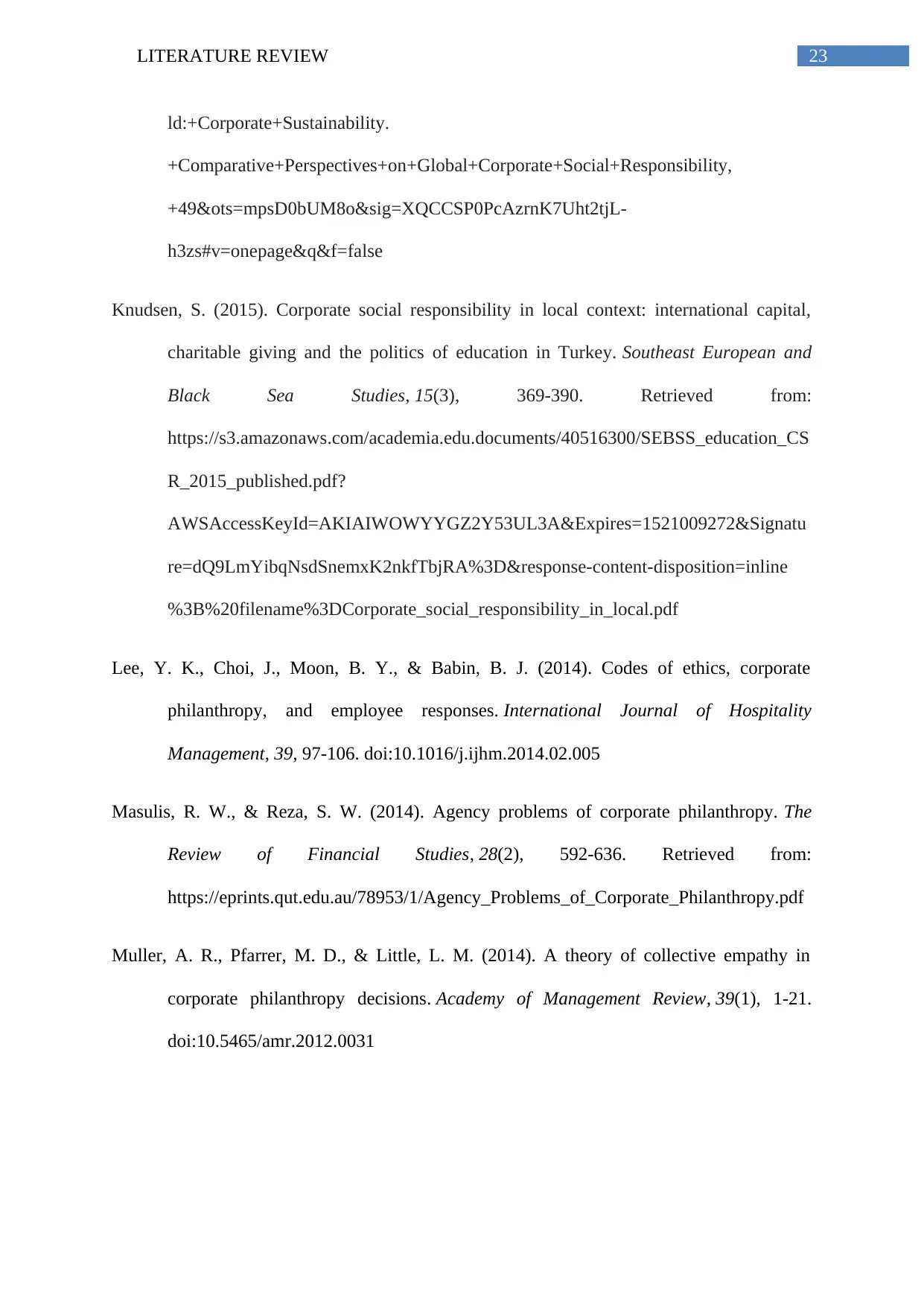
23LITERATURE REVIEW
ld:+Corporate+Sustainability.
+Comparative+Perspectives+on+Global+Corporate+Social+Responsibility,
+49&ots=mpsD0bUM8o&sig=XQCCSP0PcAzrnK7Uht2tjL-
h3zs#v=onepage&q&f=false
Knudsen, S. (2015). Corporate social responsibility in local context: international capital,
charitable giving and the politics of education in Turkey. Southeast European and
Black Sea Studies, 15(3), 369-390. Retrieved from:
https://s3.amazonaws.com/academia.edu.documents/40516300/SEBSS_education_CS
R_2015_published.pdf?
AWSAccessKeyId=AKIAIWOWYYGZ2Y53UL3A&Expires=1521009272&Signatu
re=dQ9LmYibqNsdSnemxK2nkfTbjRA%3D&response-content-disposition=inline
%3B%20filename%3DCorporate_social_responsibility_in_local.pdf
Lee, Y. K., Choi, J., Moon, B. Y., & Babin, B. J. (2014). Codes of ethics, corporate
philanthropy, and employee responses. International Journal of Hospitality
Management, 39, 97-106. doi:10.1016/j.ijhm.2014.02.005
Masulis, R. W., & Reza, S. W. (2014). Agency problems of corporate philanthropy. The
Review of Financial Studies, 28(2), 592-636. Retrieved from:
https://eprints.qut.edu.au/78953/1/Agency_Problems_of_Corporate_Philanthropy.pdf
Muller, A. R., Pfarrer, M. D., & Little, L. M. (2014). A theory of collective empathy in
corporate philanthropy decisions. Academy of Management Review, 39(1), 1-21.
doi:10.5465/amr.2012.0031
ld:+Corporate+Sustainability.
+Comparative+Perspectives+on+Global+Corporate+Social+Responsibility,
+49&ots=mpsD0bUM8o&sig=XQCCSP0PcAzrnK7Uht2tjL-
h3zs#v=onepage&q&f=false
Knudsen, S. (2015). Corporate social responsibility in local context: international capital,
charitable giving and the politics of education in Turkey. Southeast European and
Black Sea Studies, 15(3), 369-390. Retrieved from:
https://s3.amazonaws.com/academia.edu.documents/40516300/SEBSS_education_CS
R_2015_published.pdf?
AWSAccessKeyId=AKIAIWOWYYGZ2Y53UL3A&Expires=1521009272&Signatu
re=dQ9LmYibqNsdSnemxK2nkfTbjRA%3D&response-content-disposition=inline
%3B%20filename%3DCorporate_social_responsibility_in_local.pdf
Lee, Y. K., Choi, J., Moon, B. Y., & Babin, B. J. (2014). Codes of ethics, corporate
philanthropy, and employee responses. International Journal of Hospitality
Management, 39, 97-106. doi:10.1016/j.ijhm.2014.02.005
Masulis, R. W., & Reza, S. W. (2014). Agency problems of corporate philanthropy. The
Review of Financial Studies, 28(2), 592-636. Retrieved from:
https://eprints.qut.edu.au/78953/1/Agency_Problems_of_Corporate_Philanthropy.pdf
Muller, A. R., Pfarrer, M. D., & Little, L. M. (2014). A theory of collective empathy in
corporate philanthropy decisions. Academy of Management Review, 39(1), 1-21.
doi:10.5465/amr.2012.0031
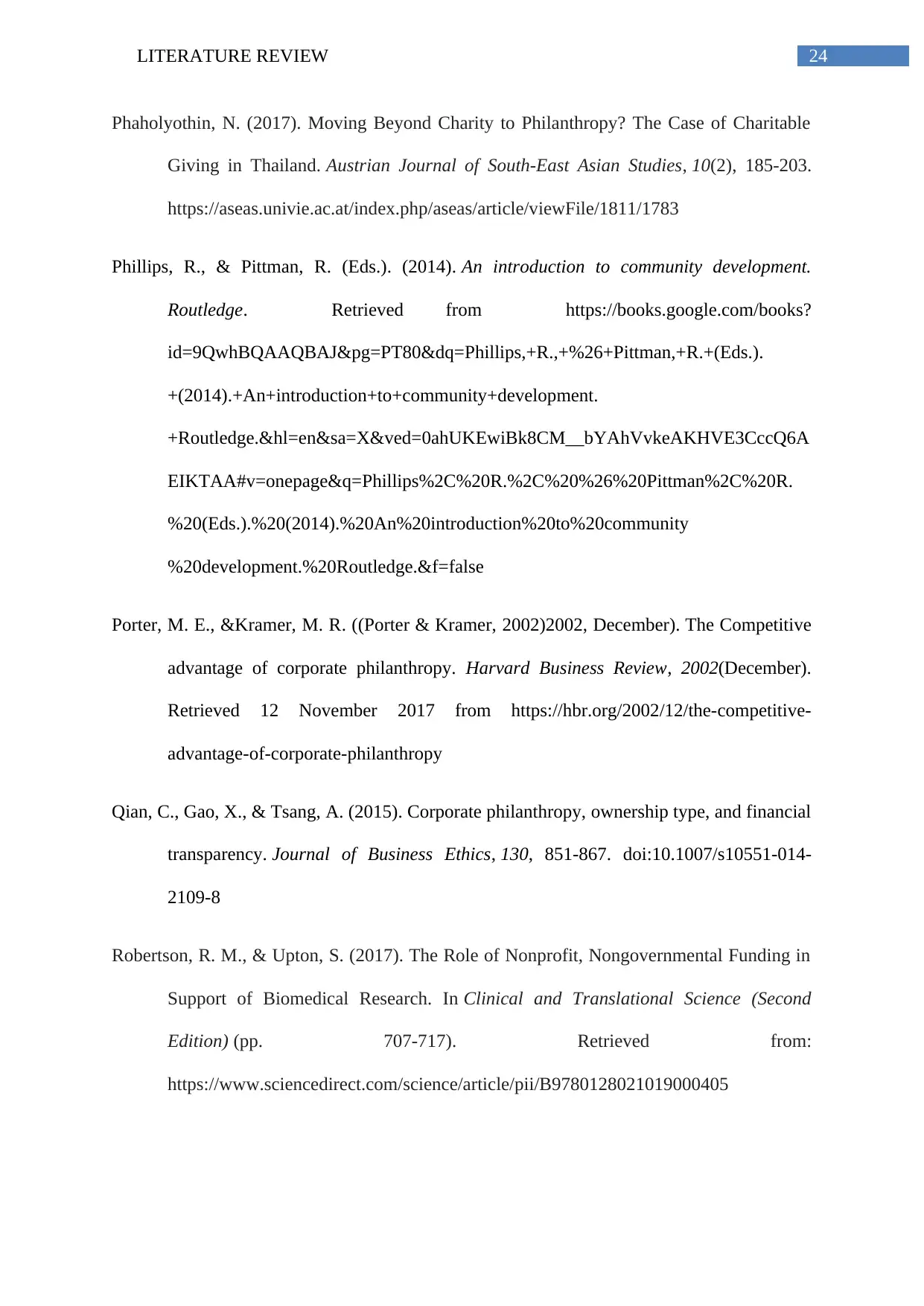
24LITERATURE REVIEW
Phaholyothin, N. (2017). Moving Beyond Charity to Philanthropy? The Case of Charitable
Giving in Thailand. Austrian Journal of South-East Asian Studies, 10(2), 185-203.
https://aseas.univie.ac.at/index.php/aseas/article/viewFile/1811/1783
Phillips, R., & Pittman, R. (Eds.). (2014). An introduction to community development.
Routledge. Retrieved from https://books.google.com/books?
id=9QwhBQAAQBAJ&pg=PT80&dq=Phillips,+R.,+%26+Pittman,+R.+(Eds.).
+(2014).+An+introduction+to+community+development.
+Routledge.&hl=en&sa=X&ved=0ahUKEwiBk8CM__bYAhVvkeAKHVE3CccQ6A
EIKTAA#v=onepage&q=Phillips%2C%20R.%2C%20%26%20Pittman%2C%20R.
%20(Eds.).%20(2014).%20An%20introduction%20to%20community
%20development.%20Routledge.&f=false
Porter, M. E., &Kramer, M. R. ((Porter & Kramer, 2002)2002, December). The Competitive
advantage of corporate philanthropy. Harvard Business Review, 2002(December).
Retrieved 12 November 2017 from https://hbr.org/2002/12/the-competitive-
advantage-of-corporate-philanthropy
Qian, C., Gao, X., & Tsang, A. (2015). Corporate philanthropy, ownership type, and financial
transparency. Journal of Business Ethics, 130, 851-867. doi:10.1007/s10551-014-
2109-8
Robertson, R. M., & Upton, S. (2017). The Role of Nonprofit, Nongovernmental Funding in
Support of Biomedical Research. In Clinical and Translational Science (Second
Edition) (pp. 707-717). Retrieved from:
https://www.sciencedirect.com/science/article/pii/B9780128021019000405
Phaholyothin, N. (2017). Moving Beyond Charity to Philanthropy? The Case of Charitable
Giving in Thailand. Austrian Journal of South-East Asian Studies, 10(2), 185-203.
https://aseas.univie.ac.at/index.php/aseas/article/viewFile/1811/1783
Phillips, R., & Pittman, R. (Eds.). (2014). An introduction to community development.
Routledge. Retrieved from https://books.google.com/books?
id=9QwhBQAAQBAJ&pg=PT80&dq=Phillips,+R.,+%26+Pittman,+R.+(Eds.).
+(2014).+An+introduction+to+community+development.
+Routledge.&hl=en&sa=X&ved=0ahUKEwiBk8CM__bYAhVvkeAKHVE3CccQ6A
EIKTAA#v=onepage&q=Phillips%2C%20R.%2C%20%26%20Pittman%2C%20R.
%20(Eds.).%20(2014).%20An%20introduction%20to%20community
%20development.%20Routledge.&f=false
Porter, M. E., &Kramer, M. R. ((Porter & Kramer, 2002)2002, December). The Competitive
advantage of corporate philanthropy. Harvard Business Review, 2002(December).
Retrieved 12 November 2017 from https://hbr.org/2002/12/the-competitive-
advantage-of-corporate-philanthropy
Qian, C., Gao, X., & Tsang, A. (2015). Corporate philanthropy, ownership type, and financial
transparency. Journal of Business Ethics, 130, 851-867. doi:10.1007/s10551-014-
2109-8
Robertson, R. M., & Upton, S. (2017). The Role of Nonprofit, Nongovernmental Funding in
Support of Biomedical Research. In Clinical and Translational Science (Second
Edition) (pp. 707-717). Retrieved from:
https://www.sciencedirect.com/science/article/pii/B9780128021019000405
Paraphrase This Document
Need a fresh take? Get an instant paraphrase of this document with our AI Paraphraser
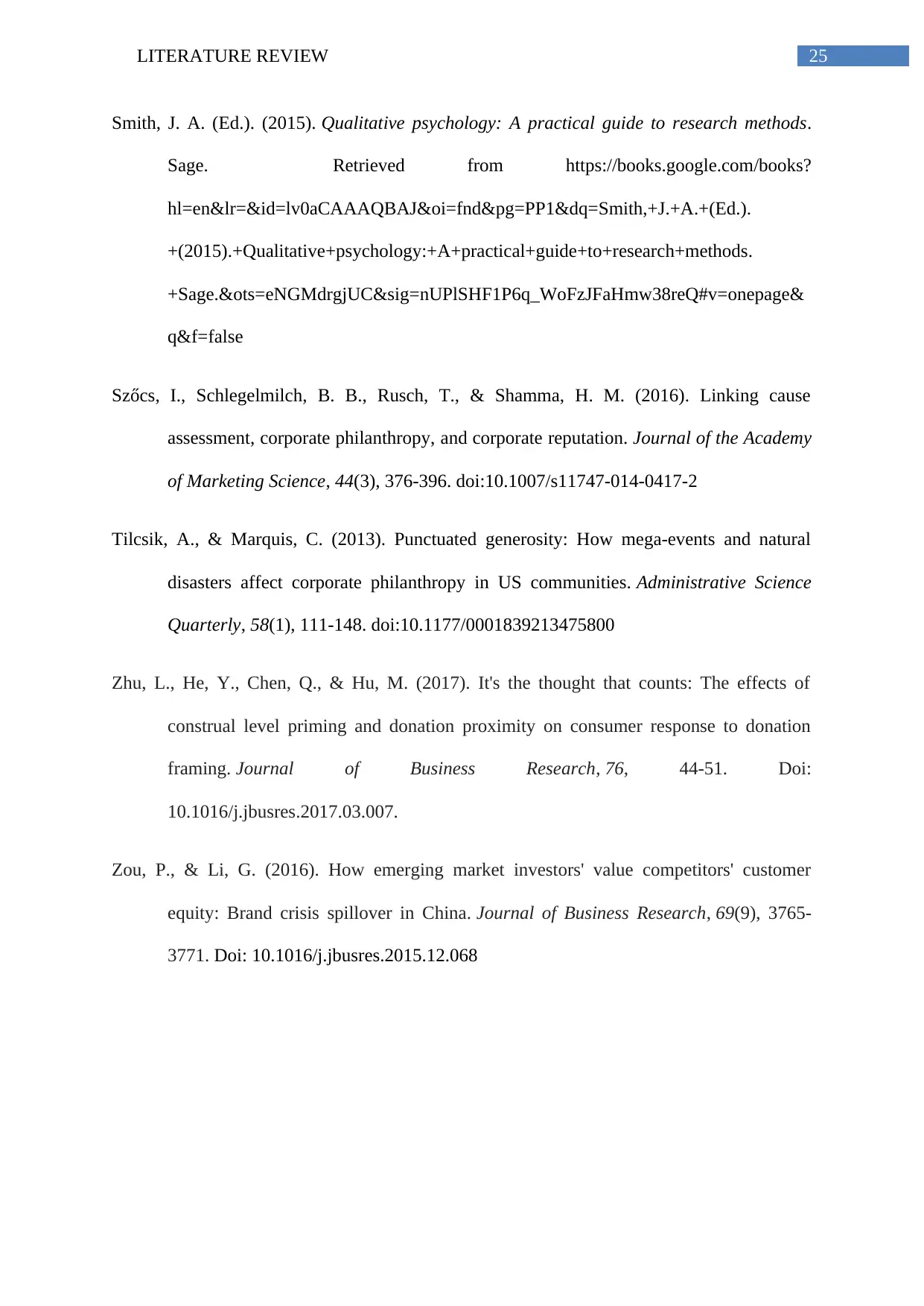
25LITERATURE REVIEW
Smith, J. A. (Ed.). (2015). Qualitative psychology: A practical guide to research methods.
Sage. Retrieved from https://books.google.com/books?
hl=en&lr=&id=lv0aCAAAQBAJ&oi=fnd&pg=PP1&dq=Smith,+J.+A.+(Ed.).
+(2015).+Qualitative+psychology:+A+practical+guide+to+research+methods.
+Sage.&ots=eNGMdrgjUC&sig=nUPlSHF1P6q_WoFzJFaHmw38reQ#v=onepage&
q&f=false
Szőcs, I., Schlegelmilch, B. B., Rusch, T., & Shamma, H. M. (2016). Linking cause
assessment, corporate philanthropy, and corporate reputation. Journal of the Academy
of Marketing Science, 44(3), 376-396. doi:10.1007/s11747-014-0417-2
Tilcsik, A., & Marquis, C. (2013). Punctuated generosity: How mega-events and natural
disasters affect corporate philanthropy in US communities. Administrative Science
Quarterly, 58(1), 111-148. doi:10.1177/0001839213475800
Zhu, L., He, Y., Chen, Q., & Hu, M. (2017). It's the thought that counts: The effects of
construal level priming and donation proximity on consumer response to donation
framing. Journal of Business Research, 76, 44-51. Doi:
10.1016/j.jbusres.2017.03.007.
Zou, P., & Li, G. (2016). How emerging market investors' value competitors' customer
equity: Brand crisis spillover in China. Journal of Business Research, 69(9), 3765-
3771. Doi: 10.1016/j.jbusres.2015.12.068
Smith, J. A. (Ed.). (2015). Qualitative psychology: A practical guide to research methods.
Sage. Retrieved from https://books.google.com/books?
hl=en&lr=&id=lv0aCAAAQBAJ&oi=fnd&pg=PP1&dq=Smith,+J.+A.+(Ed.).
+(2015).+Qualitative+psychology:+A+practical+guide+to+research+methods.
+Sage.&ots=eNGMdrgjUC&sig=nUPlSHF1P6q_WoFzJFaHmw38reQ#v=onepage&
q&f=false
Szőcs, I., Schlegelmilch, B. B., Rusch, T., & Shamma, H. M. (2016). Linking cause
assessment, corporate philanthropy, and corporate reputation. Journal of the Academy
of Marketing Science, 44(3), 376-396. doi:10.1007/s11747-014-0417-2
Tilcsik, A., & Marquis, C. (2013). Punctuated generosity: How mega-events and natural
disasters affect corporate philanthropy in US communities. Administrative Science
Quarterly, 58(1), 111-148. doi:10.1177/0001839213475800
Zhu, L., He, Y., Chen, Q., & Hu, M. (2017). It's the thought that counts: The effects of
construal level priming and donation proximity on consumer response to donation
framing. Journal of Business Research, 76, 44-51. Doi:
10.1016/j.jbusres.2017.03.007.
Zou, P., & Li, G. (2016). How emerging market investors' value competitors' customer
equity: Brand crisis spillover in China. Journal of Business Research, 69(9), 3765-
3771. Doi: 10.1016/j.jbusres.2015.12.068
1 out of 26
Your All-in-One AI-Powered Toolkit for Academic Success.
+13062052269
info@desklib.com
Available 24*7 on WhatsApp / Email
![[object Object]](/_next/static/media/star-bottom.7253800d.svg)
Unlock your academic potential
© 2024 | Zucol Services PVT LTD | All rights reserved.
